Special Report
Best City to Live in Every State
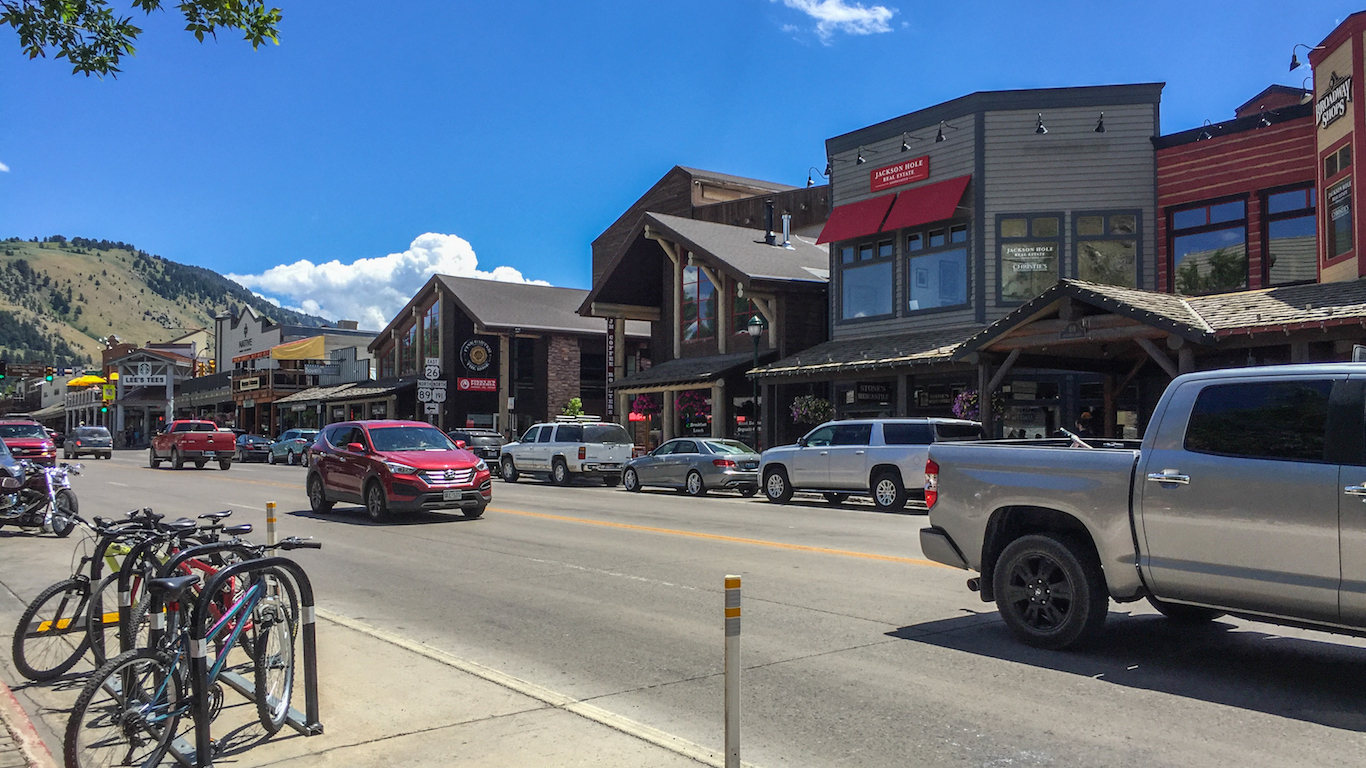
Published:
Last Updated:

There are nearly 20,000 villages, towns, and cities across the 50 states, and not all of them are equally conducive to the well-being of those who live there. While quality of life is subject to a range of factors — close relationships and personal health being among the most important — the local community and environment can also have a meaningful impact.
When it comes to choosing a place to call home, everyone has their own priorities and subjective tastes. Still, there are specific attributes some communities share that are almost universally desirable: safe streets, a strong economy, affordability, and a range of entertainment options, to name a few.
24/7 Wall St. created a weighted index of over two dozen measures from the U.S. Census Bureau, the FBI, and other sources to identify the best city to live in each state. We considered all boroughs, census designated places, cities, towns, and villages with at least 8,000 residents.
These cities tend to have much in common beyond the index components upon which they were ranked. For one, these communities are often within commuting distance of a major metropolitan area. This is no coincidence, as close proximity to a major city provides residents with access to more job opportunities; which in turn can help lower unemployment and improve financial security. Places where more residents have completed a college education also tend to be more affluent. Several of the cities on this list also can be found on this list of the most educated city in every state.
The best cities to live in include ones just outside of Atlanta, Boston, Chicago, Los Angeles, New York City, Oklahoma City, Pittsburgh, and Washington. These metro areas are highly desirable places to live, but the downside is that they also tend to be very expensive. Here is a list of the county with the most expensive housing market in every state.
Click here to see the best city to live in every state
Click here to read our methodology
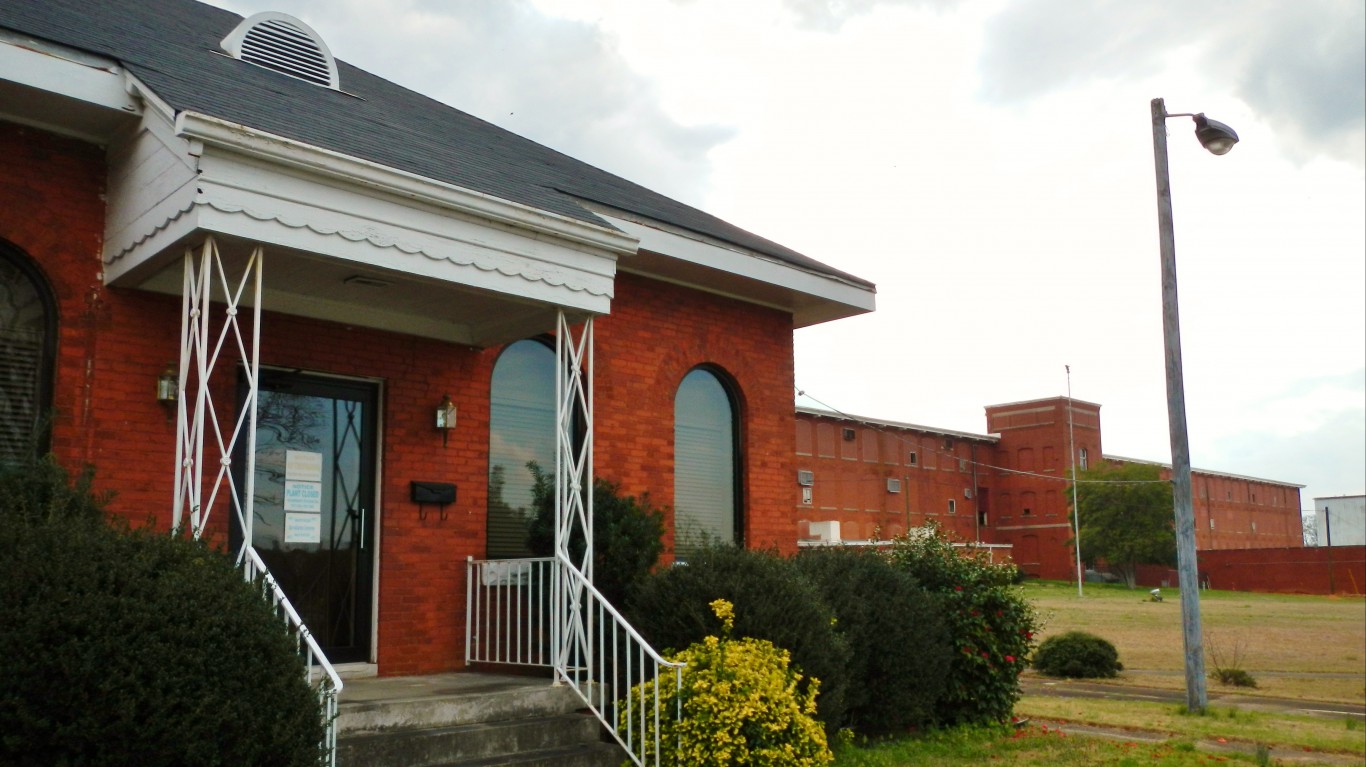
1. Valley, Alabama
> Population: 9,439
> 5 yr. population change: -0.8%
> Median home value: $82,900
> Median household income: $39,387
The majority of the cities on this list are relatively wealthy. Valley, Alabama is an exception. The typical household in Valley earns just $39,387 a year, about $5,000 less than the typical Alabama household. Still, serious financial hardship is less common in Valley than in Alabama as a whole as 15.7% of area residents live below the poverty line, well below the 18.4% state poverty rate. Valley residents also benefit from a low cost of living as goods and services are about 6% less expensive in the city than they are nationwide on average.
Valley is a pilot city for the Alabama Communities of Excellence program, a non-profit that partners with governments, businesses, and universities to prepare participating communities for a more vibrant future.
[in-text-ad]
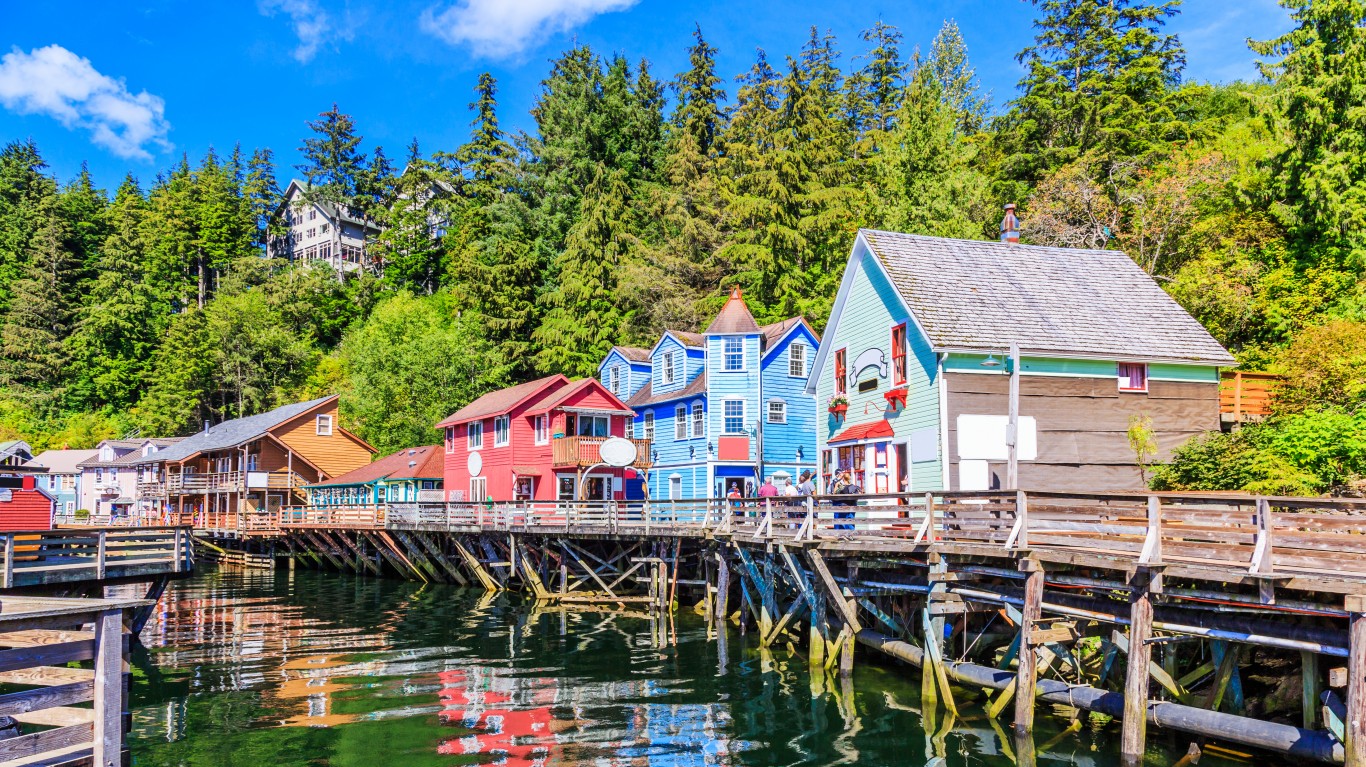
2. Ketchikan, Alaska
> Population: 8,189
> 5 yr. population change: +2.3%
> Median home value: $232,500
> Median household income: $53,937
Health outcomes are an important factor in the overall quality of life in a given area. In Ketchikan, Alaska, the mortality rate of people admitted to the hospital is 12.2 per 100,000 hospital admissions within 30 days. That figure is the lowest of any major metropolitan area in the state. Ketchikan is the only metro area in Alaska with a mortality rate lower than the U.S. mortality rate of 12.9 per 100,000.
Thanks to its scenery along the southeastern coast of Alaska and proximity to the continental United States, Ketchikan is a popular tourist destination, especially on cruises. Though much of Alaska is isolated and rural, Ketchikan offers residents and visitors access to many more entertainment options than most parts of the state — which can be important during the long, dark winters. Ketchikan has more bars, restaurants, and movie theaters than almost anywhere else in the state.
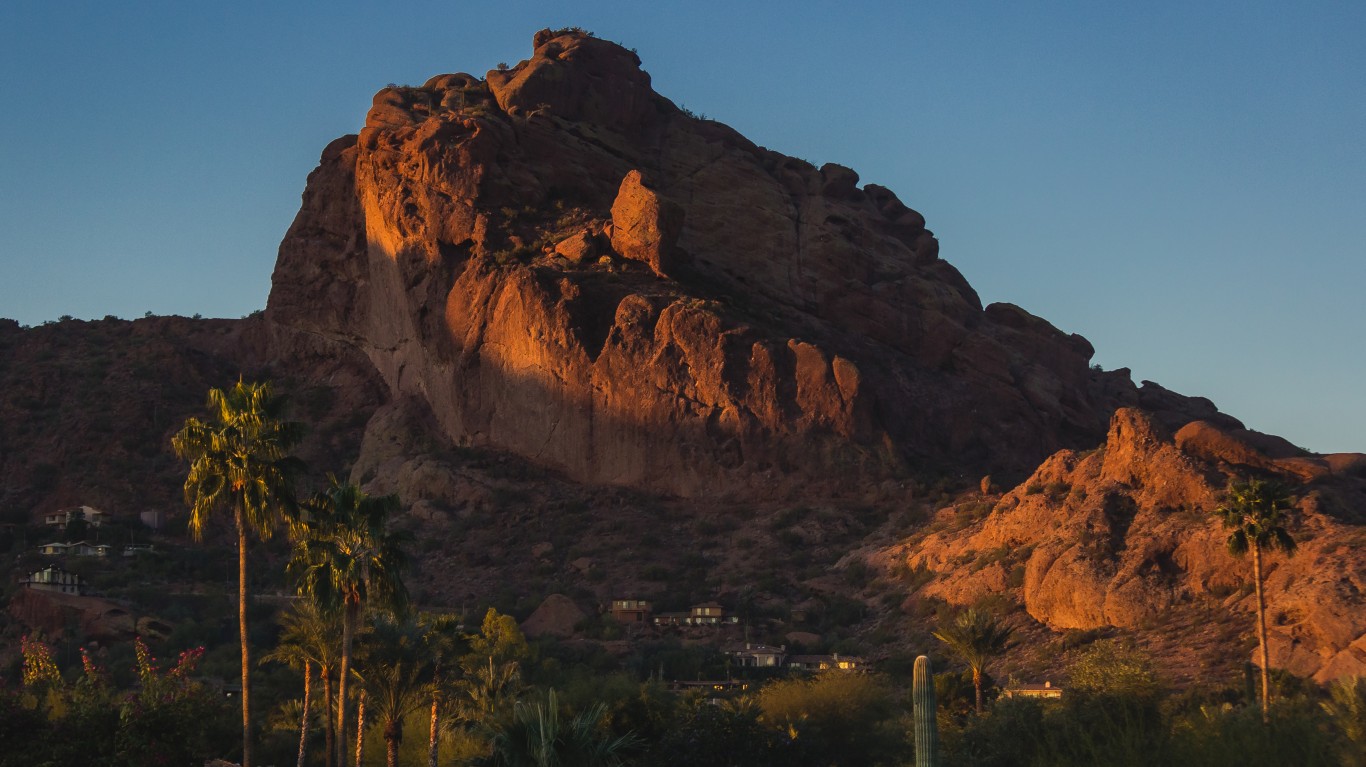
3. Paradise Valley, Arizona
> Population: 13,833
> 5 yr. population change: +5.6%
> Median home value: $1,332,600
> Median household income: $173,487
Most houses in Paradise Valley, Arizona, are worth over $1.3 million, more than seven times the U.S. median home value. Paradise Valley residents are able to afford such expensive houses because of their relatively high incomes. The typical household in the city earns $173,487 a year, one of the highest median household incomes in the country.
Paradise Valley lives up to its name as a popular destination to relax. The town is home to several resorts and a number of golf courses. Located just north of Phoenix and Scottsdale, it is also known for its high-end dining and nightlife.
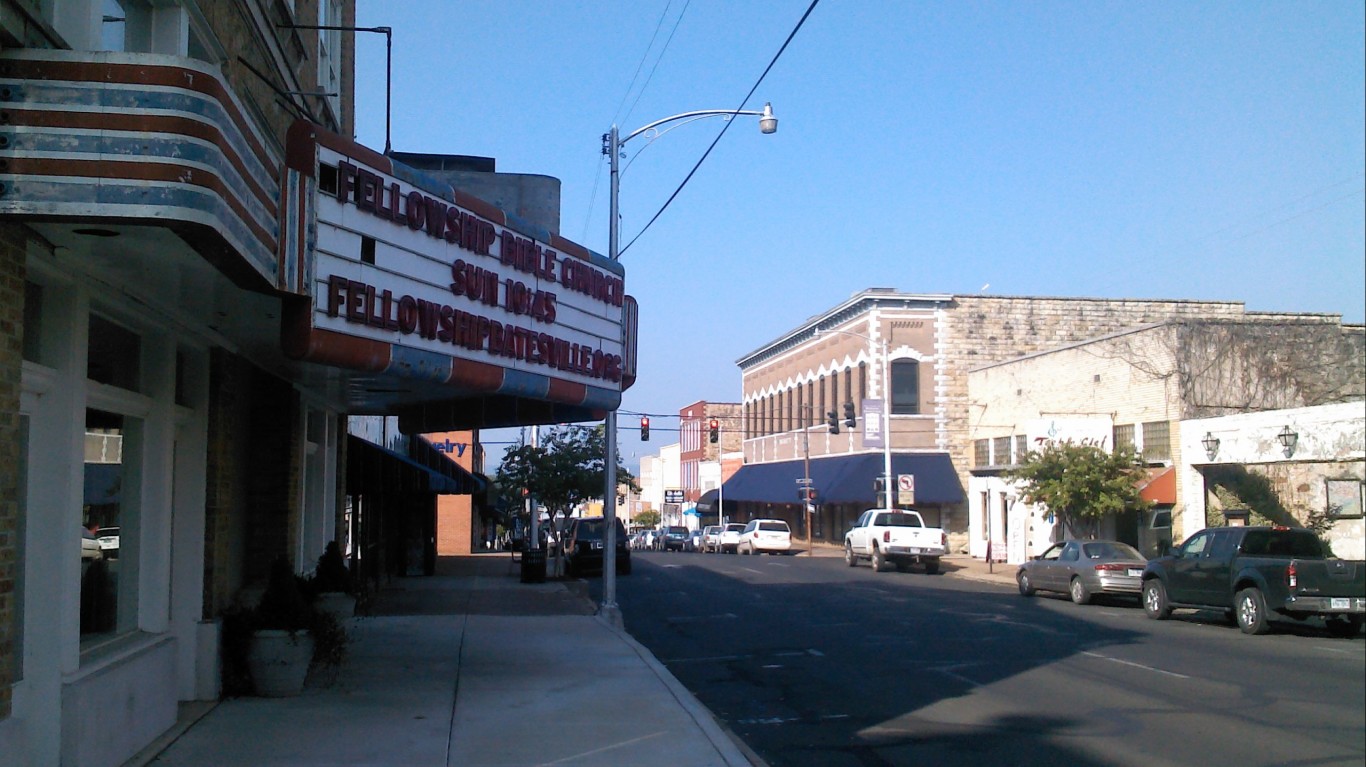
4. Batesville, Arkansas
> Population: 10,579
> 5 yr. population change: +4.5%
> Median home value: $120,400
> Median household income: $42,143
Batesville, Arkansas, ranks among the best U.S. cities to live largely due to its affordability and community attractions and amenities. Most homeowners in Batesville pay less than $1,000 a year in property taxes, less than half the amount the typical American homeowner pays. Overall annual housing costs typically come to about $7,500 a year, roughly $4,600 less than the median costs nationwide. Goods and services are 16% less expensive on average in Batesville than they are nationwide.
With roots as far back as 1804, Batesville is the second oldest city in Arkansas. The city, which avoided destruction in the Civil War, has a number of historic buildings and sites. There are attractions in the area for nearly every taste and preference, including antique stores, art galleries, an annual film festival, and the Batesville Motor Speedway.
[in-text-ad-2]

5. Palos Verdes Estates, California
> Population: 13,582
> 5 yr. population change: +1.3%
> Median home value: $1,609,500
> Median household income: $200,766
Located along the Pacific Coast less than 30 miles from Los Angeles, Palos Verdes Estates is the best place in California to live. One of the wealthiest neighborhoods in the country, the typical household earns over $200,000 a year, more than triple the national median household income of $55,322. Crime is virtually unheard of in Palos Verdes Estates as its violent crime rate of 22 incidents per 100,000 people is a small fraction of the national rate of 383 per 100,000.
The high ranking may not come as a surprise to those familiar with it, as it is a master-planned city, designed by the Olmsted Brothers, sons of Frederick Law Olmsted — architect of New York City’s Central Park and the Stanford University campus.
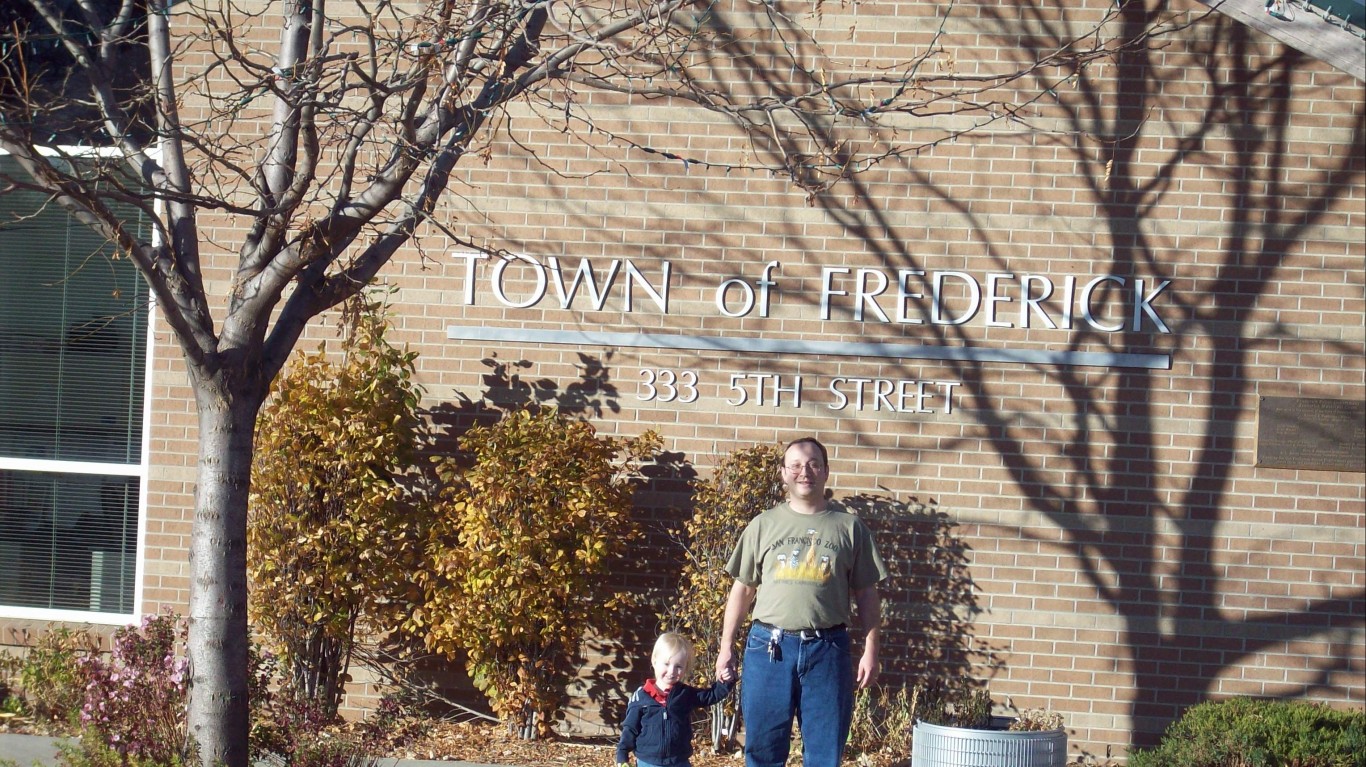
6. Frederick, Colorado
> Population: 10,791
> 5 yr. population change: +32.2%
> Median home value: $261,500
> Median household income: $90,321
Frederick, a small town about a half hour north of Denver, ranks as Colorado’s best city to live in. The town boasts a number of amenities that make it an attractive place to live, including a museum, a golf course, over 20 community parks, 25 skiing areas in driving distance, and over 300 sunny days a year.
Like many communities on this list, Frederick is relatively affluent and fast growing. The typical area household earns $90,321 a year, about $27,800 more than the median income across Colorado as a whole. Additionally, in the last five years, the number of people living in Frederick climbed 32.2%. For reference, the U.S. population grew by just 3.9% over the same period.
[in-text-ad]

7. Darien, Connecticut
> Population: 21,519
> 5 yr. population change: +4.6%
> Median home value: $1,248,200
> Median household income: $208,125
Darien, Connecticut is home to one of the wealthiest and best educated populations in the country. Well over half of all households in Darien earn at least $200,000 a year and about four out of five adults in Darien have a bachelor’s degree or higher. Nationwide, fewer than one in three adults have a bachelor’s degree. A high median income is bolstered not only by high educational attainment, but also by a strong job market. Just 3.6% of workers in Darien were unemployed in 2017, below the 4.7% state and 4.4% national 2017 unemployment rates.
Darien is also one of the safest communities in the country. There were just 14 violent crimes for every 100,000 residents in 2017, a fraction of the 383 violent crimes per 100,000 people nationwide.
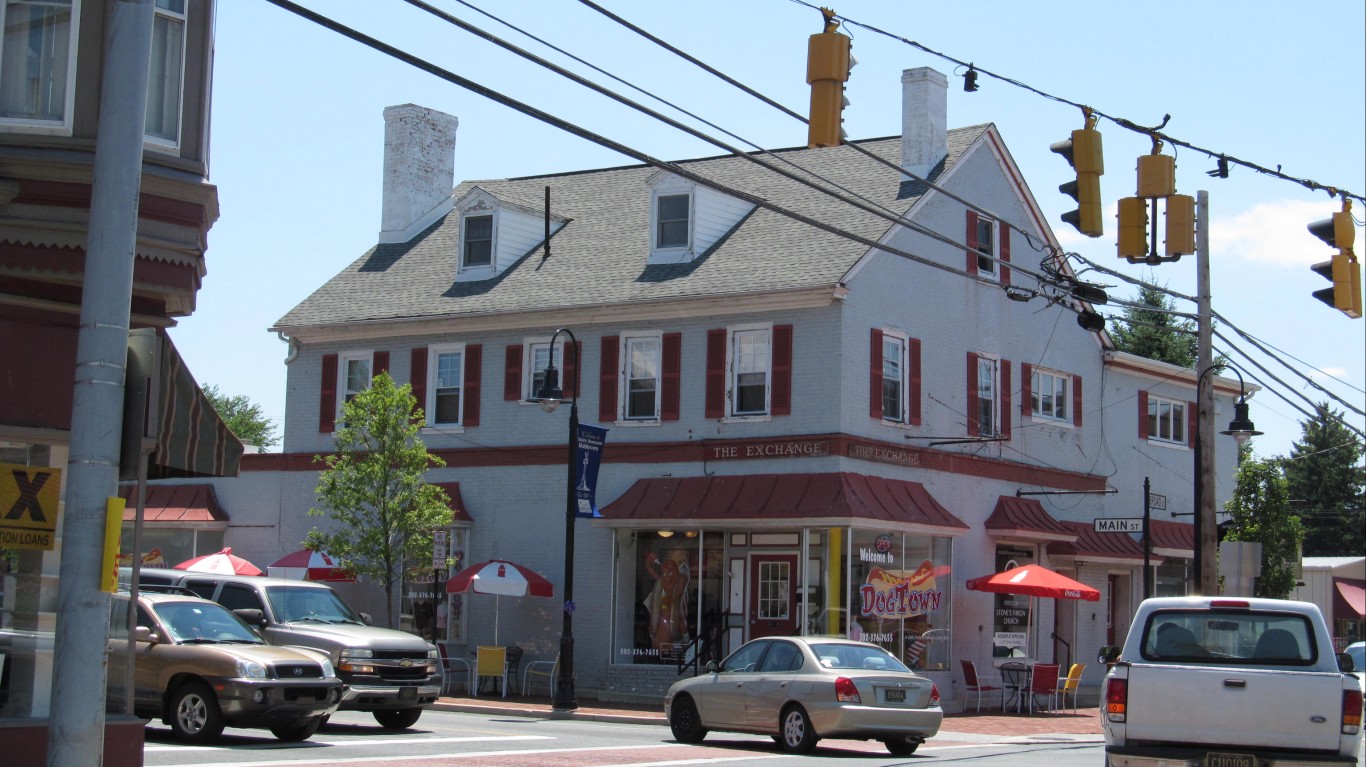
8. Middletown, Delaware
> Population: 20,045
> 5 yr. population change: +13.8%
> Median home value: $274,400
> Median household income: $87,250
Middletown ranks as the best community in Delaware to live in. The town boasts several public parks with a range of amenities, including tennis and basketball courts, soccer and baseball fields, pavilions, a track, and a pool. A relatively affluent area, Middletown has a median income of $87,250, about $26,200 more than the median income in Delaware as a whole. Home values are also about 18% higher than the average across the state and over half of all homes in Middletown are worth over a quarter-million dollars.
Like many of the cities and towns on this list, Middletown is growing rapidly. In the last five years, Middletown’s population climbed 13.8%.
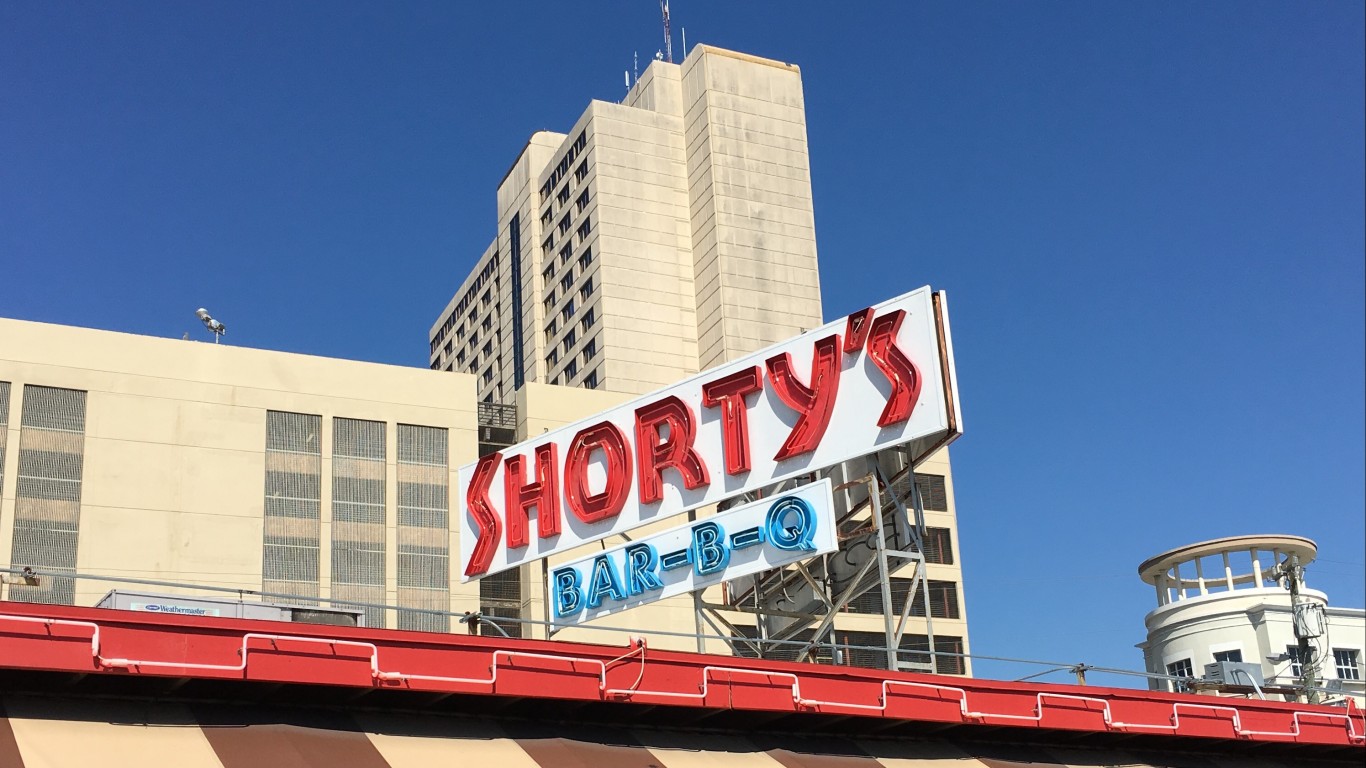
9. Pinecrest, Florida
> Population: 19,272
> 5 yr. population change: +5.2%
> Median home value: $840,900
> Median household income: $130,900
Pinecrest is by far the wealthiest place in Florida, and one of the wealthiest in the entire country. With a median household income of $130,900, most Pinecrest households earn more than double what the typical Florida household earns, which is $48,900. Partially because of the area’s relatively high income, the typical home in Pinecrest costs more than $840,000 — more than four times the median Florida home.
A Miami suburb just off Biscayne Bay, Pinecrest is also one of the best educated areas of the state. Among adults 25 and older, 61.7% have at least a bachelor’s degree. Statewide, just 27.9% of adults finished college.
[in-text-ad-2]

10. Milton, Georgia
> Population: 36,755
> 5 yr. population change: +19.1%
> Median home value: $475,300
> Median household income: $109,784
A planned community incorporated in 2006, Milton is one of the most rapidly growing cities in Georgia. Now home to nearly 37,000 people, Milton’s population more than doubled since 2009 and is projected to reach 43,000 by 2030. In commuting distance of Atlanta, many Milton residents likely commute to high paying jobs in the state’s largest city. The typical household in Milton earns $109,784 a year, more than double the median income of $51,037 across the state as a whole. Similarly, Milton’s poverty rate of 5.5% is less than a third of the 17.8% statewide poverty rate.
Milton is also a safe city. There were just 23 violent crimes for every 100,000 residents in 2017, a fraction of the 383 per 100,000 national rate.

11. Urban Honolulu, Hawaii
> Population: 349,597
> 5 yr. population change: +4.3%
> Median home value: $601,500
> Median household income: $63,361
Education can be an important factor in the health and well being of a population. In addition to being more financial stable, college graduates tend to live longer and healthier lives than those who did not obtain at least a bachelor’s degree. A high level of education helps make Urban Honolulu the best city to live in Hawaii. Among Honolulu adults, 36% have at least a bachelor’s degree, the highest rate in Hawaii.
Long commutes by car can have a negative effect on physical and mental health. Honolulu residents utilize alternative methods of getting to and from work. Roughly one in every eight residents takes public transportation to work, while many others walk or ride their bicycles. Altogether, 22.9% of commuters do not drive themselves to their jobs, over five times more than the next closest city in Hawaii.
[in-text-ad]

12. Hailey, Idaho
> Population: 8,058
> 5 yr. population change: +2.6%
> Median home value: $266,500
> Median household income: $56,522
Hailey is situated in Idaho’s Wood River Valley in the Rocky Mountains. The city is surrounded by public land and forests where residents and visitors can hike, bike, ski, fish, and horseback ride, and is a short drive from Ketchum and Sun Valley, two resort towns.
Quality of life for residents is boosted by lower than average crime, poverty, and unemployment rates. While the median household income of $56,522 in Hailey is only about $1,000 higher than the national median income, a dollar goes further in Hailey than in much of the rest of the country. Goods and services are about 4% less expensive than they are nationwide on average.

13. Winnetka, Illinois
> Population: 12,437
> 5 yr. population change: +2.3%
> Median home value: $989,600
> Median household income: $207,857
Winnetka is a small village that sits on the shores of Lake Michigan about 15 miles north of downtown Chicago. One of the wealthiest cities in the state, the typical Winnetka household earns $207,857 a year. Winnetka residents working in Chicago have options when it comes to transit, as over one quarter of commuters use public transportation — an alternative most Americans do not have.
In the village, downtown shops were described by the Chicago Tribune in 2012 as reminiscent of the Hamptons on Long Island in New York, without the celebrities. Winnetka boasts four beaches, a boat launch, several parks, a tennis club, a golf course, an ice rink, and forest preserve areas, all open to the public.
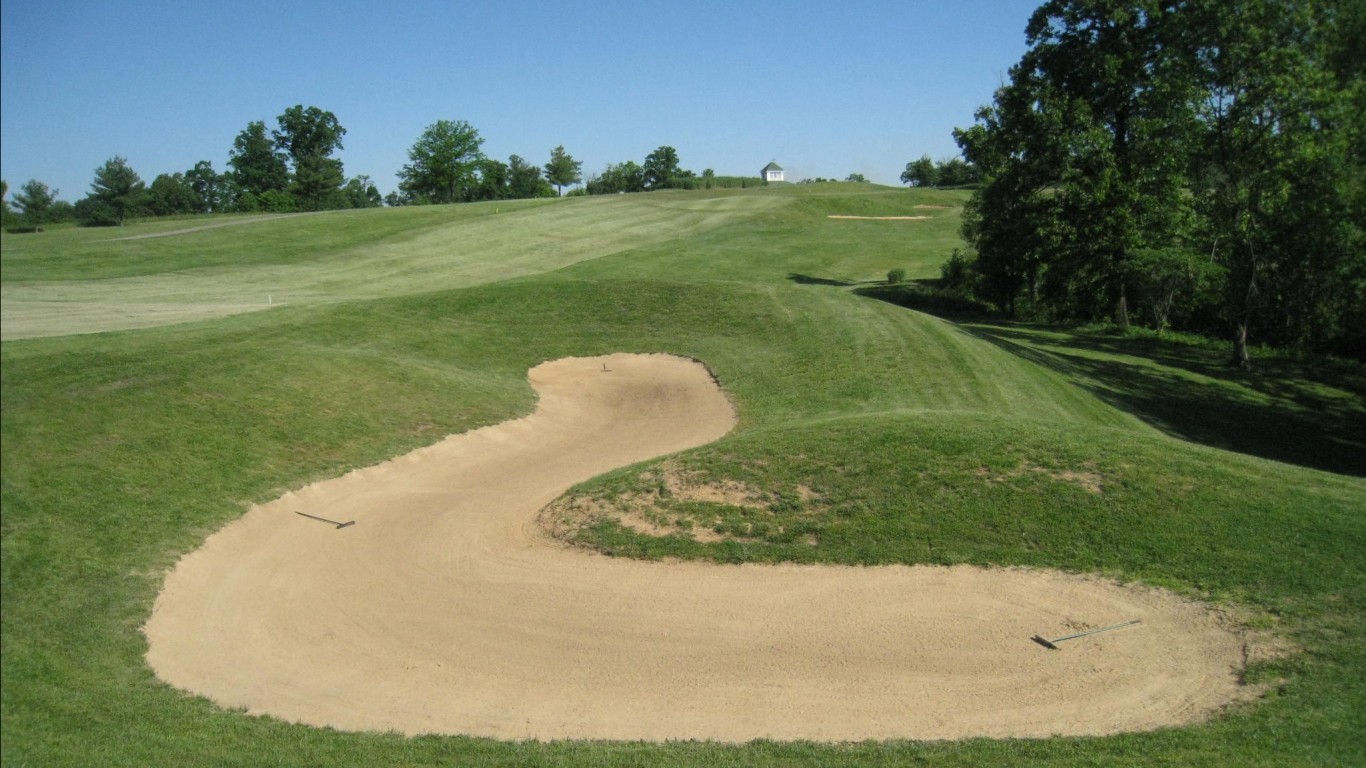
14. Jasper, Indiana
> Population: 15,790
> 5 yr. population change: +6.6%
> Median home value: $148,200
> Median household income: $55,209
Jasper is one of the most affordable places to live in Indiana. The cost of living in the city is just 83.6% of what the typical American pays. The median household income in Jasper of $55,209 is higher than Indiana’s median of $50,433. The combination of relatively high income and low costs, as compared to the rest of the state, makes Jasper residents more able to afford homes compared to those in most other areas of Indiana. The median home price in Jasper is $148,200, compared to Indiana’s median home price of $126,500.
Jasper residents are much less likely to struggle with money than the average Indiana resident. Statewide, 15% of Indiana residents live in poverty. In Jasper, the poverty rate is less than half that, at 7.1%.
[in-text-ad-2]

15. Le Mars, Iowa
> Population: 9,826
> 5 yr. population change: +1.0%
> Median home value: $139,400
> Median household income: $56,851
Le Mars, Iowa, is among the most affordable cities in the United States. Goods and services in the city cost about 15% less on average than they do nationwide. Housing is particularly inexpensive, with the typical household spending $8,124 a year, about $4,000 less than the average annual housing cost nationwide.
The city also has its share of attractions. Home to a Blue Bunny ice cream manufacturing plant, Le Mars churns out more ice cream from a single company than any other city, earning the nickname “The Ice Cream Capital of the World.” The city and surrounding area also boast a history museum, an art museum, a golf course, a campground, and of course, an ice cream museum.
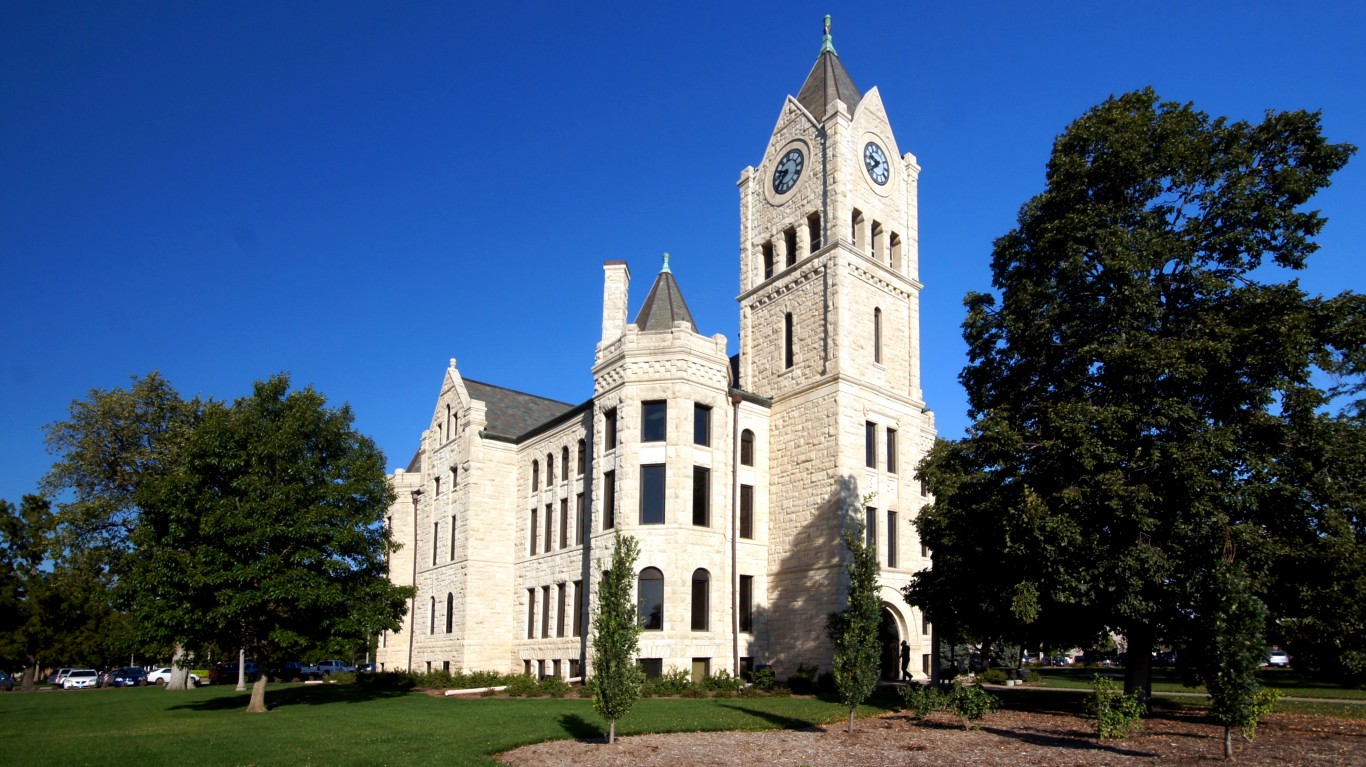
16. McPherson, Kansas
> Population: 13,212
> 5 yr. population change: +0.0%
> Median home value: $135,800
> Median household income: $54,057
The median household income in McPherson, Kansas of $54,057 a year is just below the national median of $55,322. However, a dollar goes a long way in McPherson as goods and services are 14% less expensive than they are on average nationwide. Indeed, extreme financial hardship is relatively rare in the city. Just 7.3% of residents live in poverty compared to 13.3% of the Kansas population.
McPherson residents also have many options when it comes to entertainment and recreation. The city has a far greater than typical concentration of restaurants, fitness centers, museums, golf courses, and movie theatres.
[in-text-ad]

17. Edgewood, Kentucky
> Population: 8,703
> 5 yr. population change: +0.5%
> Median home value: $204,300
> Median household income: $89,073
The best city to live in in Kentucky, Edgewood is both wealthy and affordable. The typical household in Edgewood earns $89,073, nearly double the $44,811 median income across the state as a whole. Additionally, goods and services are about 11% less expensive in Edgewood than they are nationwide on average.
Overall quality of life in Edgewood is boosted by two large public parks and an easily accessible hospital and medical care center within city limits. Located about seven miles south of Cincinnati across the Ohio River, Edgewood — like many cities on this list — is in commuting distance of a major metropolitan area.

18. Youngsville, Louisiana
> Population: 10,878
> 5 yr. population change: +41.5%
> Median home value: $222,300
> Median household income: $94,564
Youngsville is a relatively prosperous city in one of the poorest states in the country. The typical Youngsville household earns about $95,000 a year and just 5.5% of the population live in poverty. Meanwhile, the typical Louisiana household earns less than $46,000 a year and nearly one in five state residents live in poverty. A dollar also goes farther than typical in Youngsville, as goods and services are about 7% less expensive than they are on average nationwide.
Youngsville residents have benefitted from a 70 acre, multimillion dollar sports complex since its completion in 2014 and a recreation center that opened in 2016. The facility boasts 10 tennis courts, six soccer fields, five baseball fields, batting cages, a fishing pond, a one-mile walking path, and a playground.

19. Bath, Maine
> Population: 8,334
> 5 yr. population change: -3.6%
> Median home value: $164,600
> Median household income: $42,275
Bath is the best place to live in Maine. Bolstered largely by Bath Iron Works, a shipbuilding plant operated by defense giant General Dynamics, the city’s job market is relatively strong. Annual unemployment in the city, located near the mouth of the Kennebec River, stands at 3.2%, well below the 4.4% national rate. Many residents also benefit from the city’s walkability as more than one in 10 commuters in Bath walk to work, more than triple the comparable national share. The city is also relatively safe, and also has a high concentration of restaurants, fitness centers, museums, and libraries.
Despite its advantages, Bath is one of only a handful of cities on this list to be shrinking in size. Over the last five years, Bath’s population declined by 3.6%, even as the total U.S. population grew 3.9%.
[in-text-ad-2]
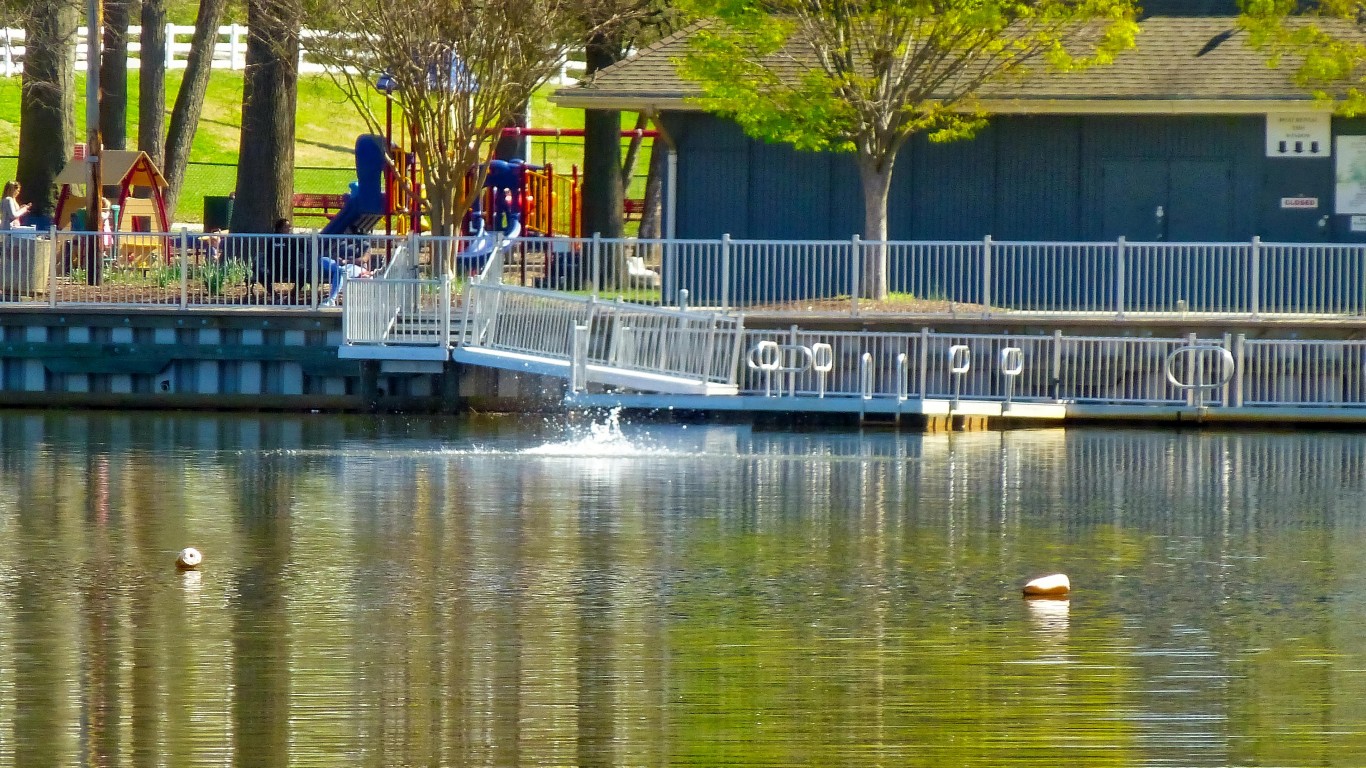
20. Bowie, Maryland
> Population: 57,633
> 5 yr. population change: +5.7%
> Median home value: $303,900
> Median household income: $106,098
Just a short commute from Washington, D.C., Bowie, Maryland, provides easy access to high-paying jobs in and around the nation’s capital. Most households in Bowie earn more than $106,000 per year — over $30,000 higher than Maryland’s state median household income. Just a small share of Bowie residents live in poverty. Its poverty rate is just 3.3%, just one-third of the state’s poverty rate.
In order to qualify for these high-level jobs, many of Bowie’s residents are well-educated. Nearly half of all adults living in Bowie hold at least a college degree, as compared to 38.4% of Maryland residents overall.
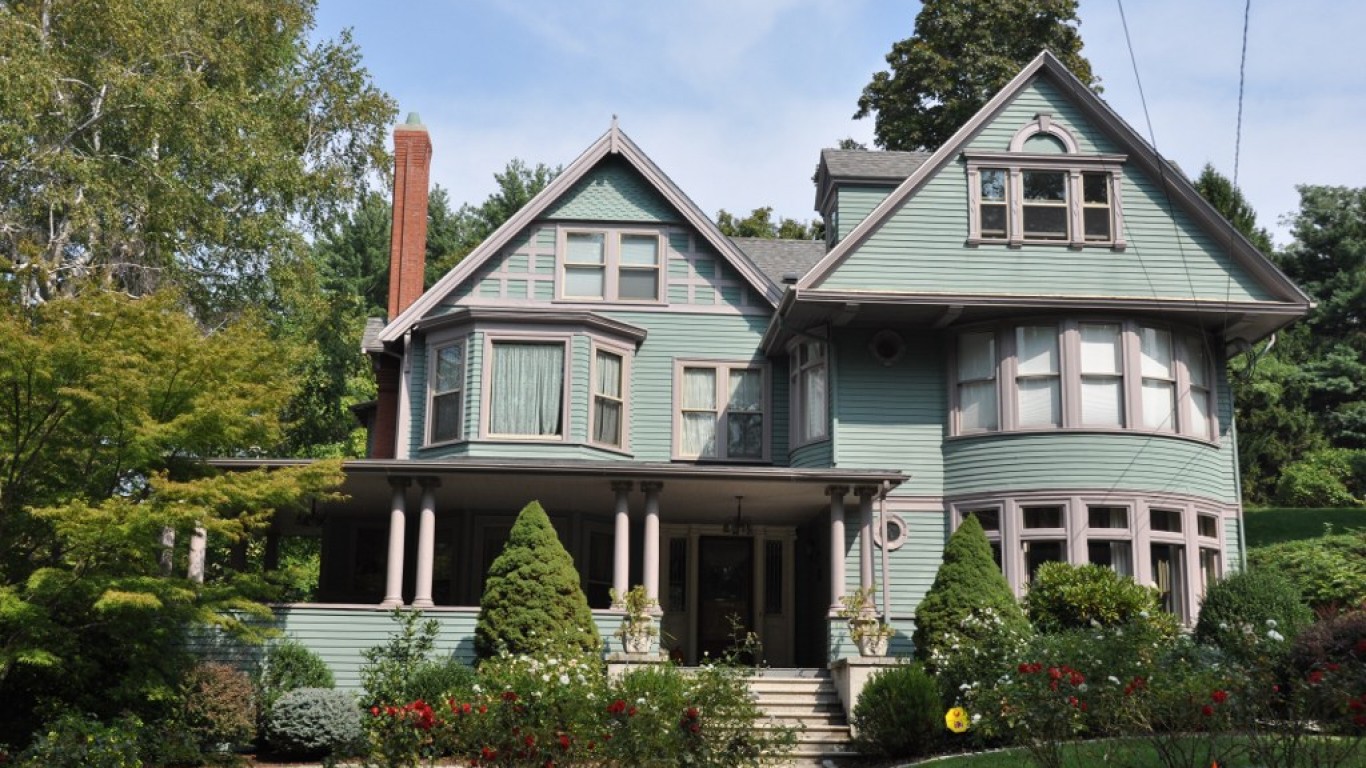
21. Winchester, Massachusetts
> Population: 22,491
> 5 yr. population change: +6.1%
> Median home value: $796,500
> Median household income: $149,321
Winchester is the best-educated place in Massachusetts and one of the most highly-educated in the entire country. Nearly three-quarters of adults in the area have at least a bachelor’s degree. This college degree attainment rate is well above that of Massachusetts, which sits at 41.2%.
This high level of education, coupled with the fact that Winchester is just outside of Boston, can make it easier for residents to find jobs. Winchester has the lowest unemployment rate, at 2.7%, of anywhere in the state. Massachusetts’ unemployment rate is a full percentage point higher. This high level of employment likely helps drive down the poverty rate in Winchester. Just 2.4% of Winchester residents live below the poverty line, the lowest share in Massachusetts.
[in-text-ad]
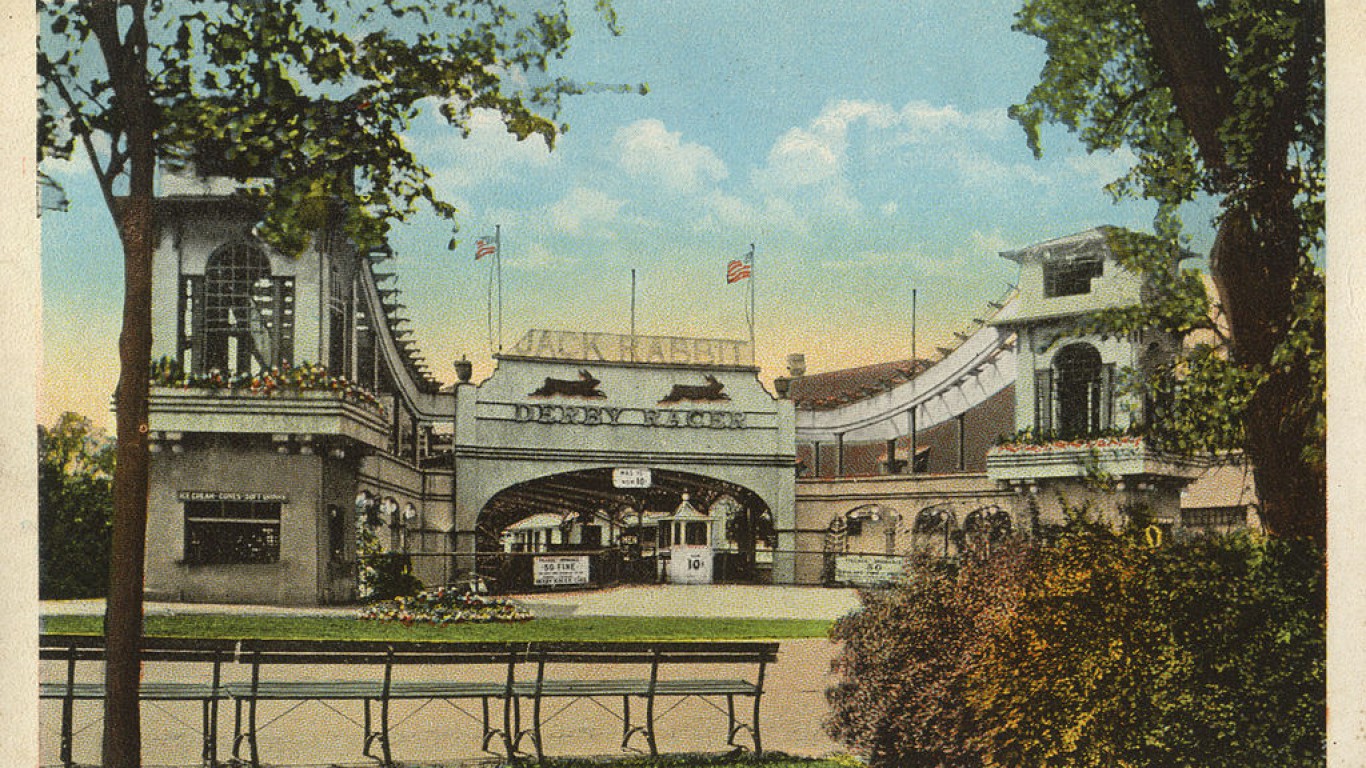
22. East Grand Rapids, Michigan
> Population: 11,297
> 5 yr. population change: +5.2%
> Median home value: $303,400
> Median household income: $118,393
East Grand Rapids is one of the wealthiest cities in both Michigan and the United States. The typical area household earns over $118,000 a year, compared to the $55,322 the typical household earns nationwide. City residents also benefit from a low cost of living as goods and services are 7% less expensive in East Grand Rapids than they are on average nationwide.
In addition to entertainment and cultural attractions in nearby Grand Rapids, East Grand Rapids has 10 parks, including a lake with a boat launch, miles of trails, playgrounds, and a baseball field.
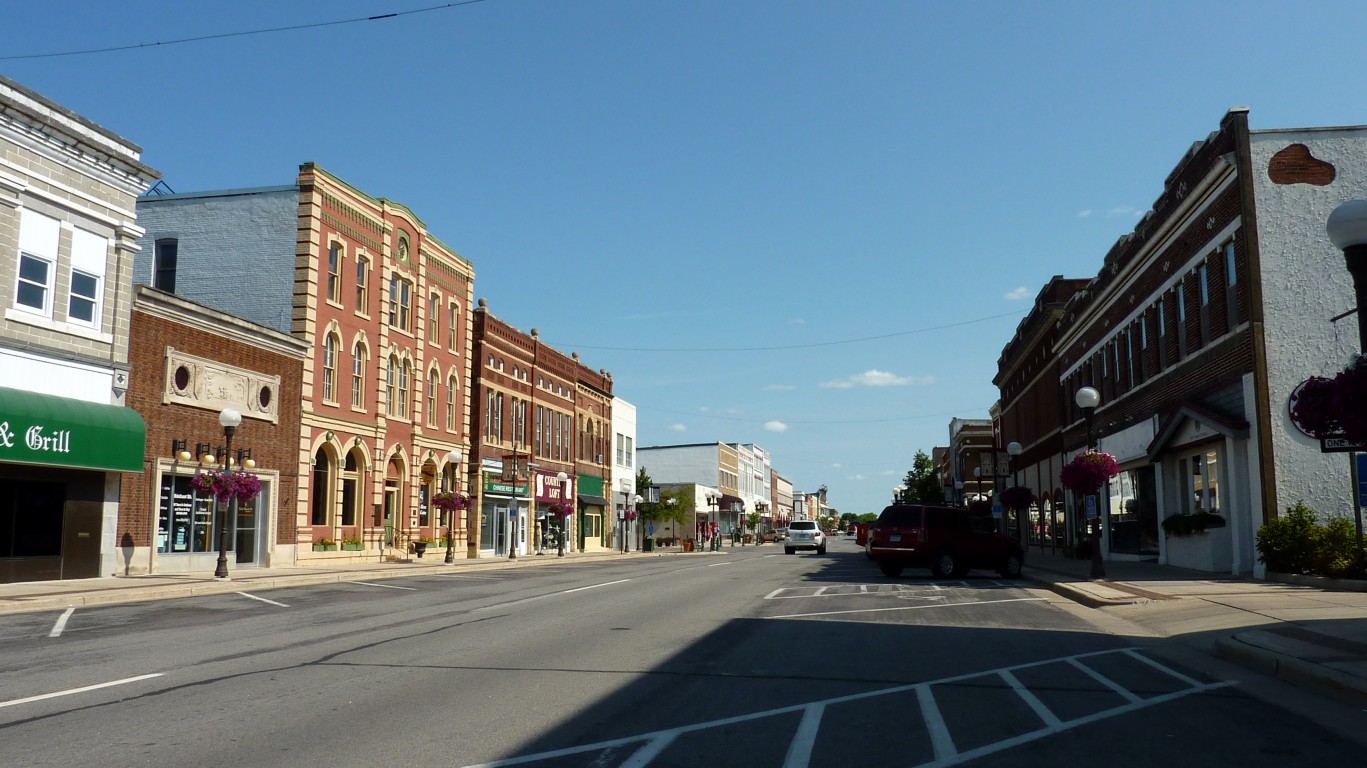
23. New Ulm, Minnesota
> Population: 13,279
> 5 yr. population change: -1.6%
> Median home value: $133,100
> Median household income: $52,244
Residents of New Ulm, Minnesota, are more likely to work and be financially secure, on average, than most other Americans. The town’s poverty rate of 8.5% is well below the national poverty rate of 15.1%. Also, the town’s five-year average unemployment rate of 2.6% is 4.8 percentage points below the comparable nationwide rate.
These numbers are better than the comparable national figures despite the fact that New Ulm residents tend to not be especially wealthy. The town’s median household income of $52,244 a year is several thousand dollars lower than the U.S. median household income. Unlike almost all other places on this list, New Ulm’s population shrank over the past five years. During a time when the U.S. population grew 3.9%, New Ulm’s population dropped 1.6%.
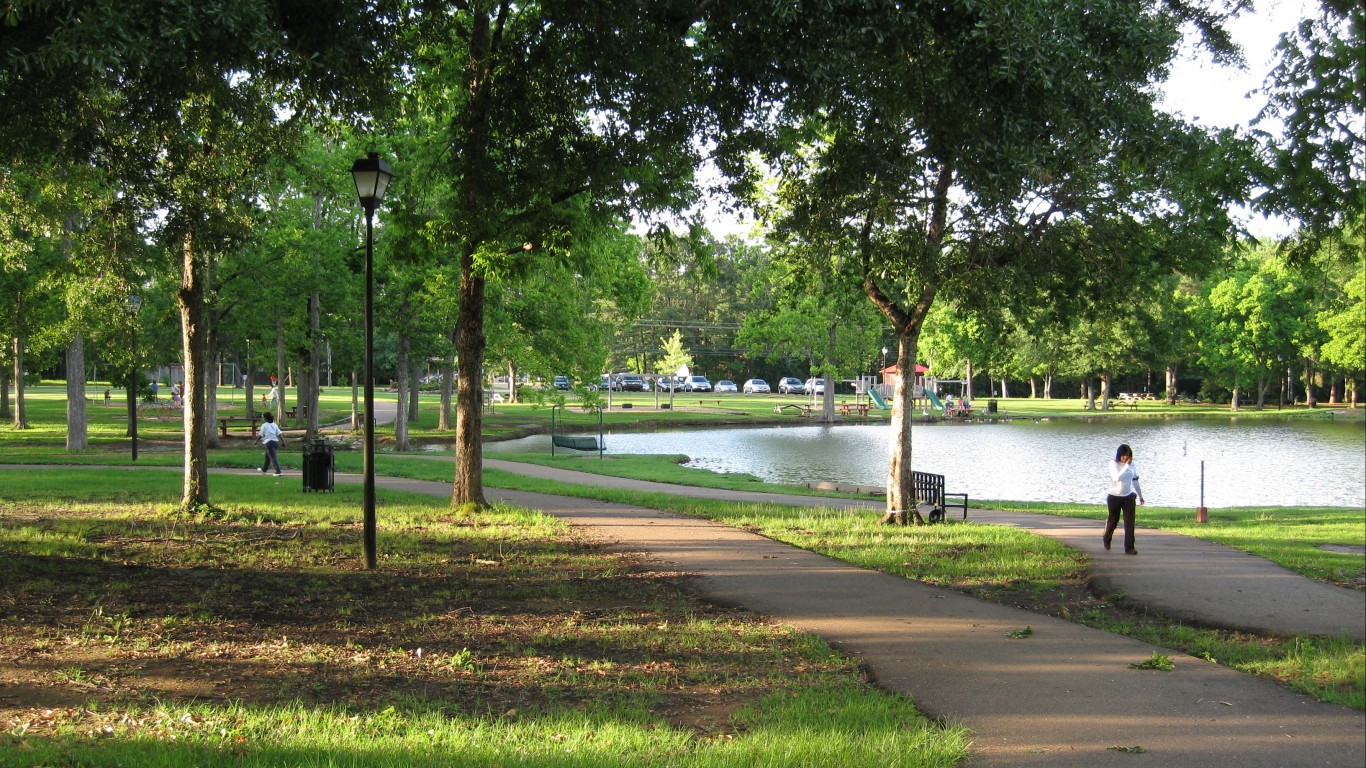
24. Madison, Mississippi
> Population: 25,473
> 5 yr. population change: +7.1%
> Median home value: $243,500
> Median household income: $100,978
Madison, a city located along a reservoir less than 20 miles north of the state capital, ranks as Mississippi’s best city to live in. Madison is a relatively wealthy community, with a median income of $100,978 — more than double the $40,528 median income statewide. The average cost of living in Madison is also about 8% lower than it is nationwide.
Madison residents have access to several public parks with amenities that include an archery range, baseball and soccer fields, walking trails, batting cages, and an outdoor learning center.
[in-text-ad-2]

25. Ladue, Missouri
> Population: 8,579
> 5 yr. population change: +1.1%
> Median home value: $771,500
> Median household income: $186,371
One of the wealthiest cities in Missouri, Ladue’s median household income of $186,371 a year is more than triple the national median income of $55,322. Not only is Ladue a wealthy city, but it is also inexpensive. Goods and services are 11% cheaper on average in Ladue than they are typically nationwide.
With easy access to jobs in nearby St. Louis, Ladue residents who want a job generally have no trouble finding one. Over the last five years, unemployment stood at just 2.0% in the city, a fraction of the national rate of 7.4%. In addition to cultural attractions and entertainment venues in St. Louis, Ladue residents enjoy a greater than typical concentration of restaurants, fitness and recreation centers, golf courses, and museums within their own city limits.

26. Miles City, Montana
> Population: 8,667
> 5 yr. population change: +3.6%
> Median home value: $130,100
> Median household income: $47,383
Miles City is the least expensive place to live in Montana. The city has the lowest property taxes at just $1,480 per year, as well as the least expensive median monthly housing cost at $655. Though Miles City’s $47,383 median household income is one of the lower such figures in Montana, a relatively small share of residents are impoverished. The area’s poverty rate of 13.5% is one of the lowest in the state, and well below Montana’s statewide poverty rate of 14.9%.
Miles City ranks as Montana’s best city to live in part because it is the safest place in the state. Its violent crime rate of 104 reported incidents per 100,000 residents is less than half the rate of the next safest place in the state. Miles City also has Montana’s lowest property crime rate.
[in-text-ad]
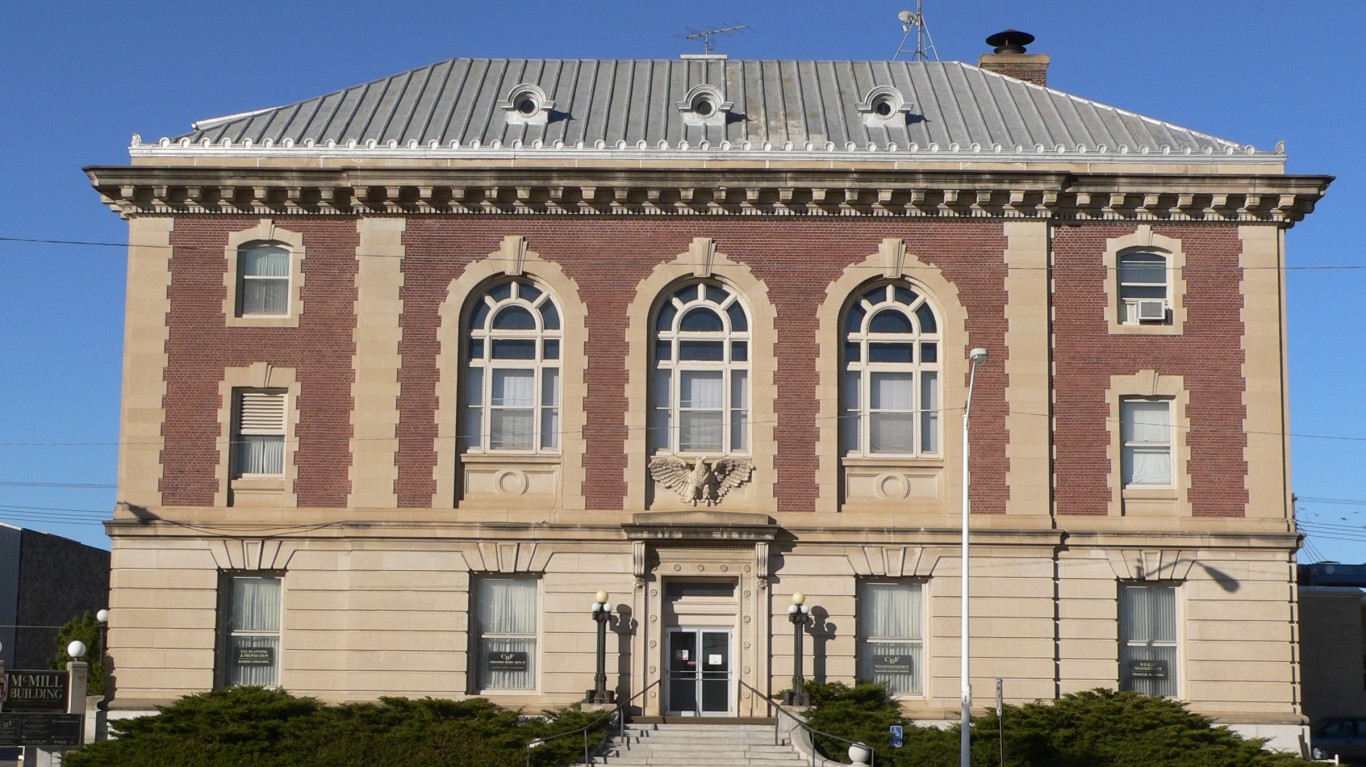
27. Norfolk, Nebraska
> Population: 24,398
> 5 yr. population change: +1.9%
> Median home value: $123,200
> Median household income: $45,401
Norfolk is a small city of just under 25,000 in northeastern Nebraska. A relatively safe city, Norfolk’s violent crime rate of 148 incidents per 100,000 residents is less than half the national rate of 383 per 100,000. Though the typical household in Norfolk earns just $45,401 a year, about $10,000 less than the typical American household, a dollar goes a long way in Norfolk. Goods and services in and around the area are about 14.5% less expensive than they are nationwide on average.
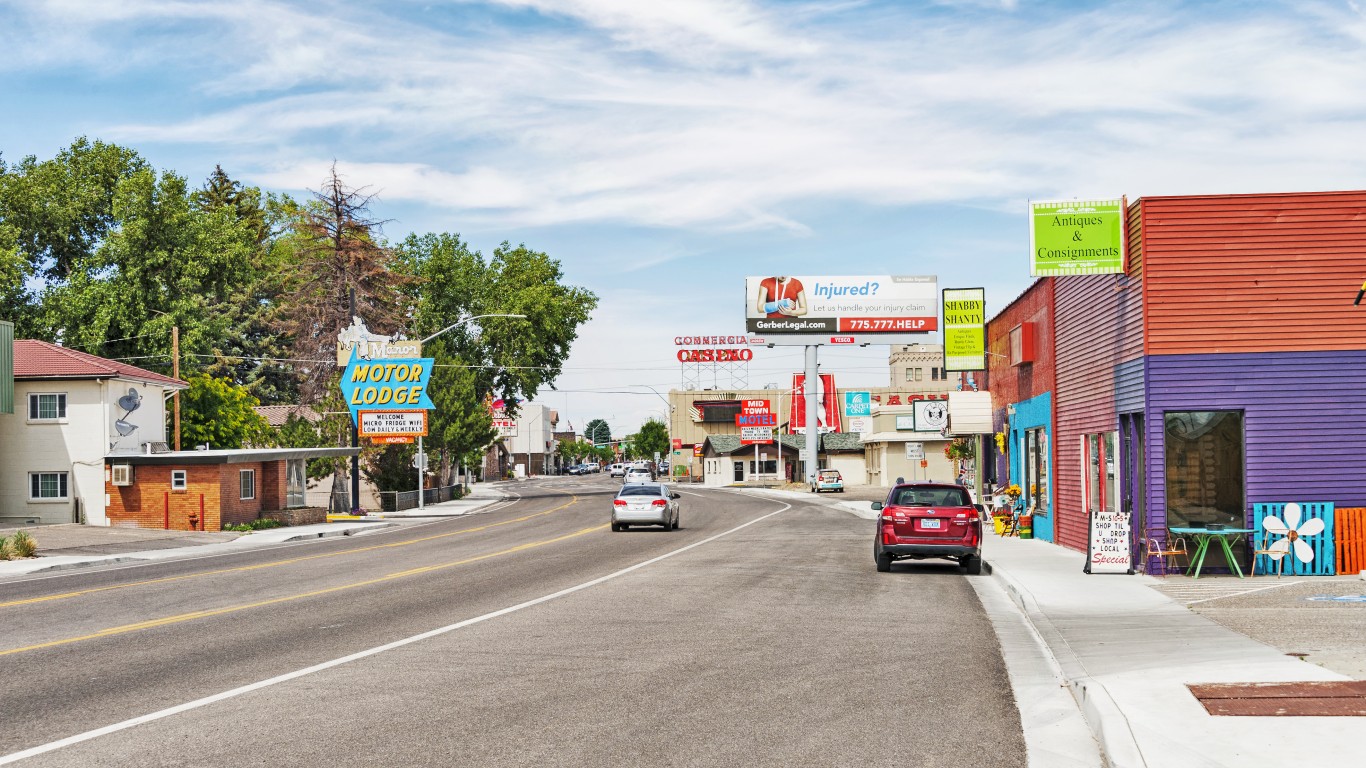
28. Elko, Nevada
> Population: 20,078
> 5 yr. population change: +11.0%
> Median home value: $215,100
> Median household income: $76,826
Elko has by far the highest median household income of anywhere in Nevada. No other area in the state came within $20,000 of Elko’s median household income of $76,826. Although Elko residents tend to earn a relatively high amount, it is the least expensive place to live in Nevada. The cost of living in Elko is just 83.9% of what it costs in the typical American city.
Elko is the fastest-growing place in Nevada by a wide margin. In the past seven years, its population increased 18.7% to just over 20,000 people. During that same timeframe, no other place in the state had a population increase of more than 10%.
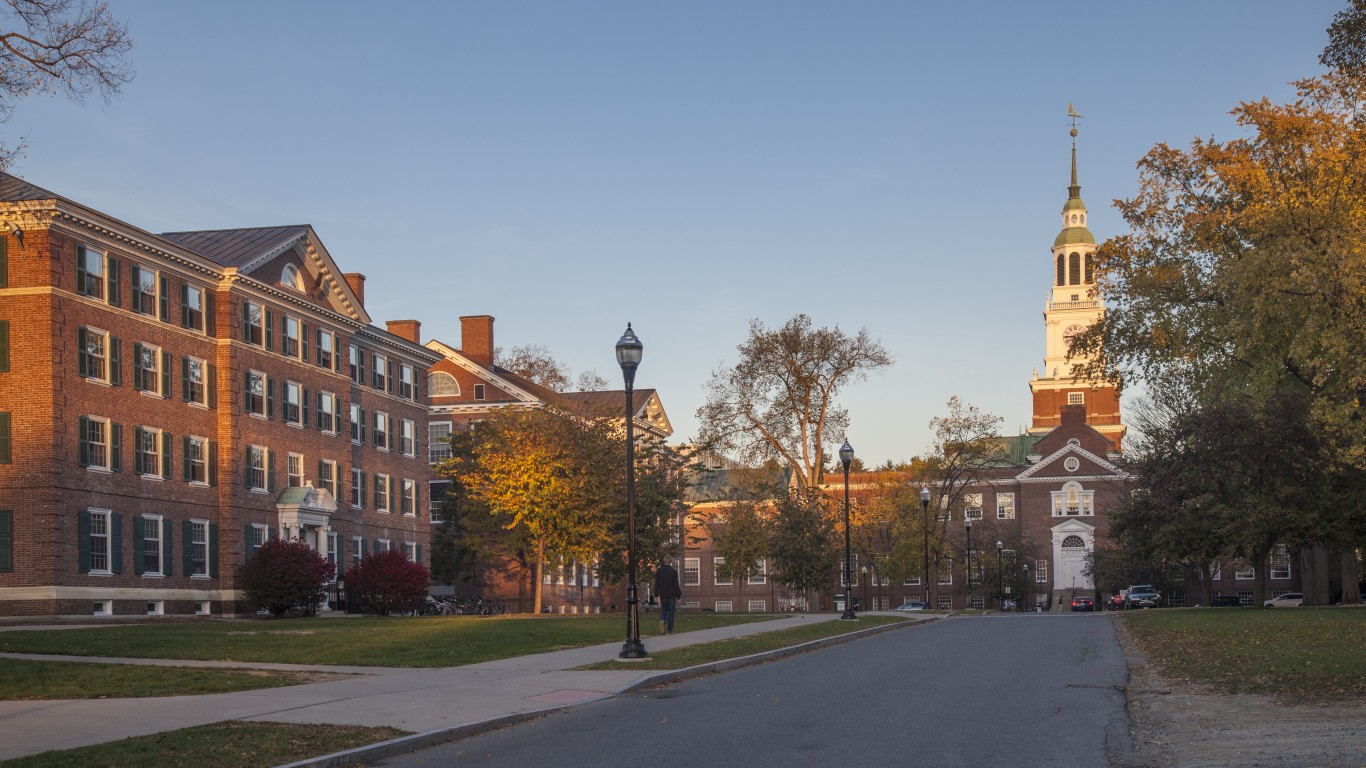
29. Hanover, New Hampshire
> Population: 8,482
> 5 yr. population change: +0.0%
> Median home value: $469,300
> Median household income: $96,406
Hanover has numerous advantages over other places in New Hampshire cities. Its median household income of $96,406 is more than $26,000 higher than the next closest city and well ahead of the statewide median, which is $68,485. Hanover is also the best educated place in the state, as 83.1% of adults hold at least a bachelor’s degree. No other city in New Hampshire comes close to that share. For comparison, the state’s bachelor’s degree attainment rate is 35.5%.
With a population of 8,482, Hanover is a smaller city. As such, many residents are able to walk to and from work. Walking not only provides numerous health benefits, but also helps decrease road traffic and reduce pollution. Some 40% of Hanover residents commute by walking — by far the highest rate in New Hampshire and the second highest rate of any U.S. city.
[in-text-ad-2]

30. Haddonfield, New Jersey
> Population: 11,444
> 5 yr. population change: -1.3%
> Median home value: $487,700
> Median household income: $135,700
Haddonfield is one of the most economically prosperous places in New Jersey and the United States as a whole. The typical Haddonfield home earns $135,700, nearly $62,000 more than the typical New Jersey household. Haddonfield lies just across the Delaware River from Philadelphia, providing its residents access to the jobs that city offers.
Compared to the rest of the state, Haddonfield residents are not likely to struggle with poverty. The area has a poverty rate of just 2.9%, well below New Jersey’s poverty rate of 10.9%. Though Haddonfield’s cost of living is 11% more than that of the average American city, it is still one of the lowest in New Jersey.
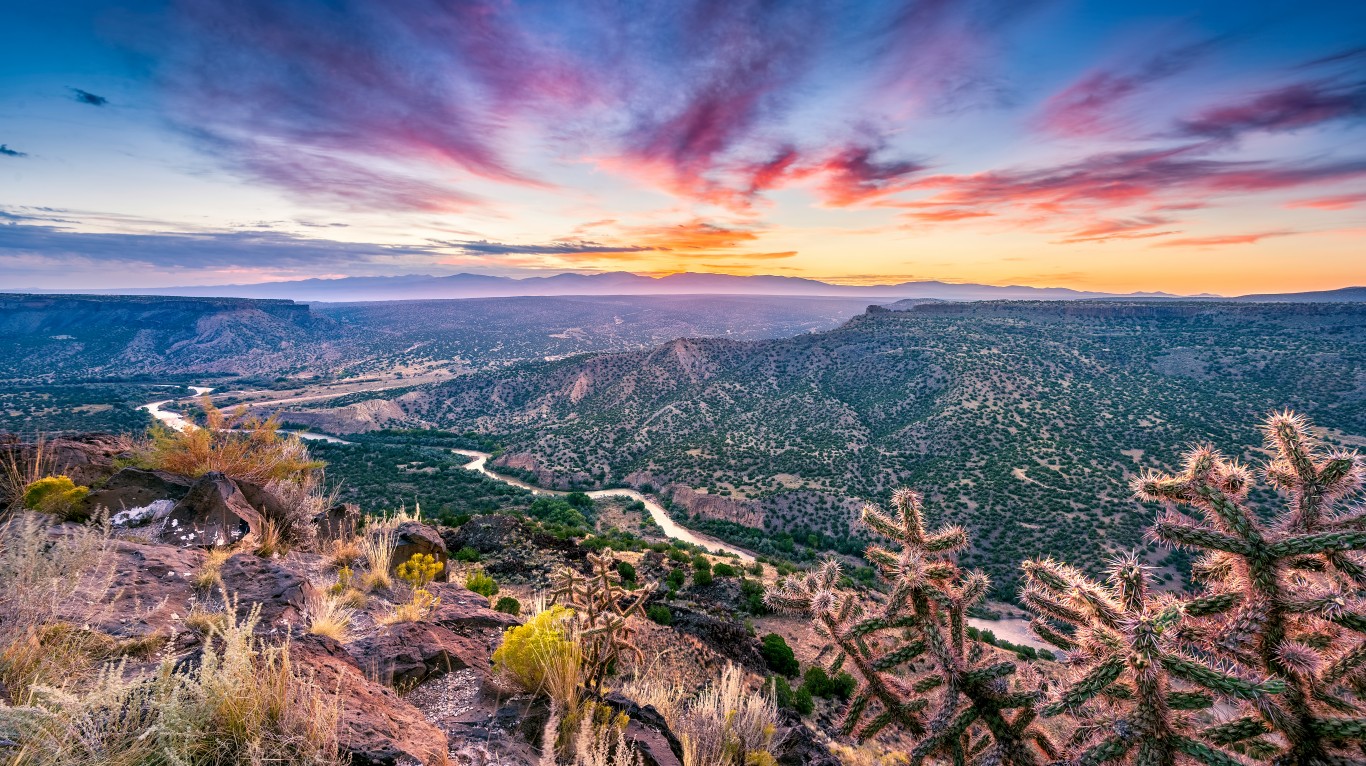
31. Los Alamos, New Mexico
> Population: 11,733
> 5 yr. population change: -2.9%
> Median home value: $277,700
> Median household income: $101,535
Los Alamos, New Mexico is flush with history, cultural amenities, and parks. These include a science museum, a theatre, nearly 100 public art installations, a network of over 90 miles of hiking trails, and the Manhattan Project National Historical Park — a monument to the city’s critical role in World War II and development of the atomic bomb. Los Alamos also has one of the best public high schools in New Mexico, according to U.S. News & World Report.
Many living in the area work at the Los Alamos National Laboratory, a facility run by the U.S. Department of Energy with a $2.6 billion budget primarily allocated to weapons development.
[in-text-ad]
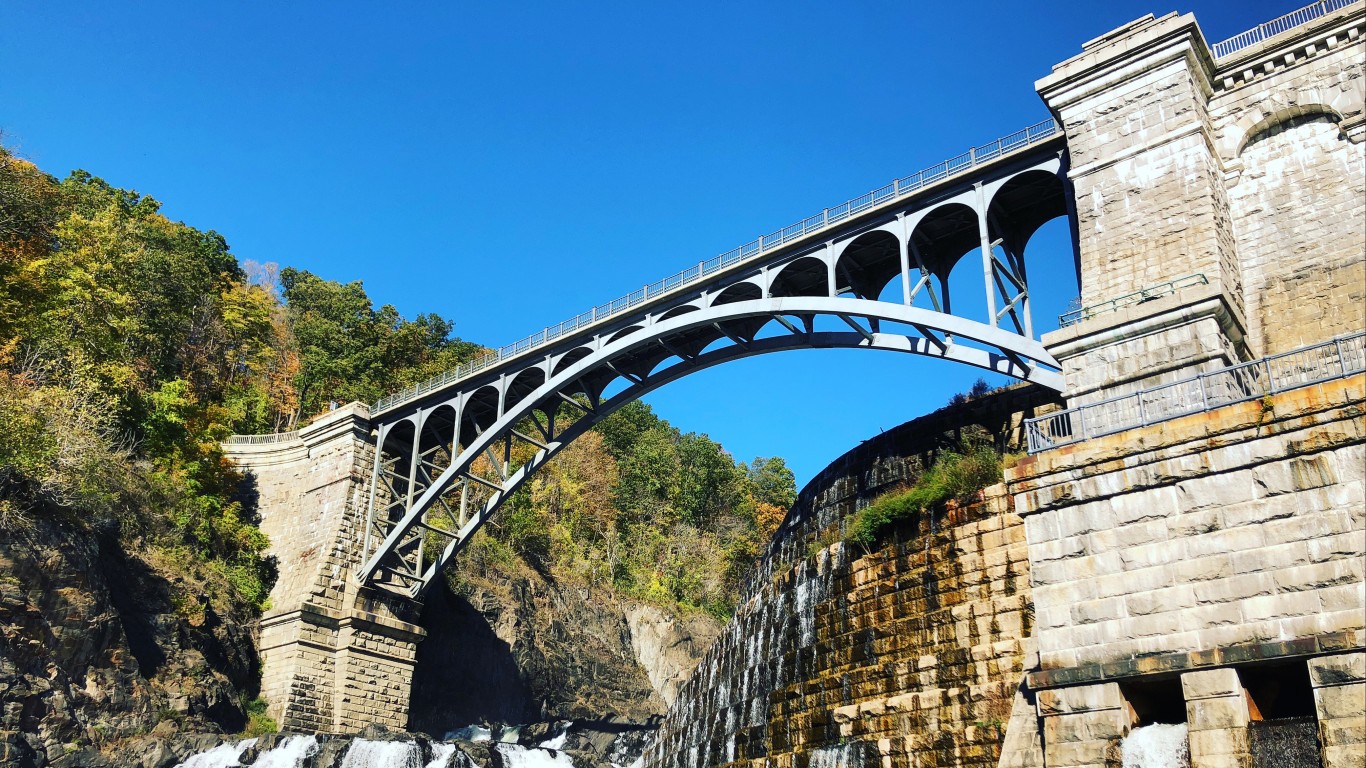
32. Croton-on-Hudson, New York
> Population: 8,209
> 5 yr. population change: +2.8%
> Median home value: $519,400
> Median household income: $117,656
Croton-on-Hudson is a small village on the eastern bank of the Hudson River, less than 40 miles north of Manhattan. The village is on a train line that goes directly into the city, and largely as a result, more than one in every four workers in Croton-on-Hudson commute using public transit. The village’s proximity to New York City contributes to high property values as most homes in the community are worth over half a million dollars.
Croton-on-Hudson is one of the safest communities in New York. There were just 48 violent crimes for every 100,000 village residents in 2017, about an eighth of the national violent crime rate of 383 per 100,000.
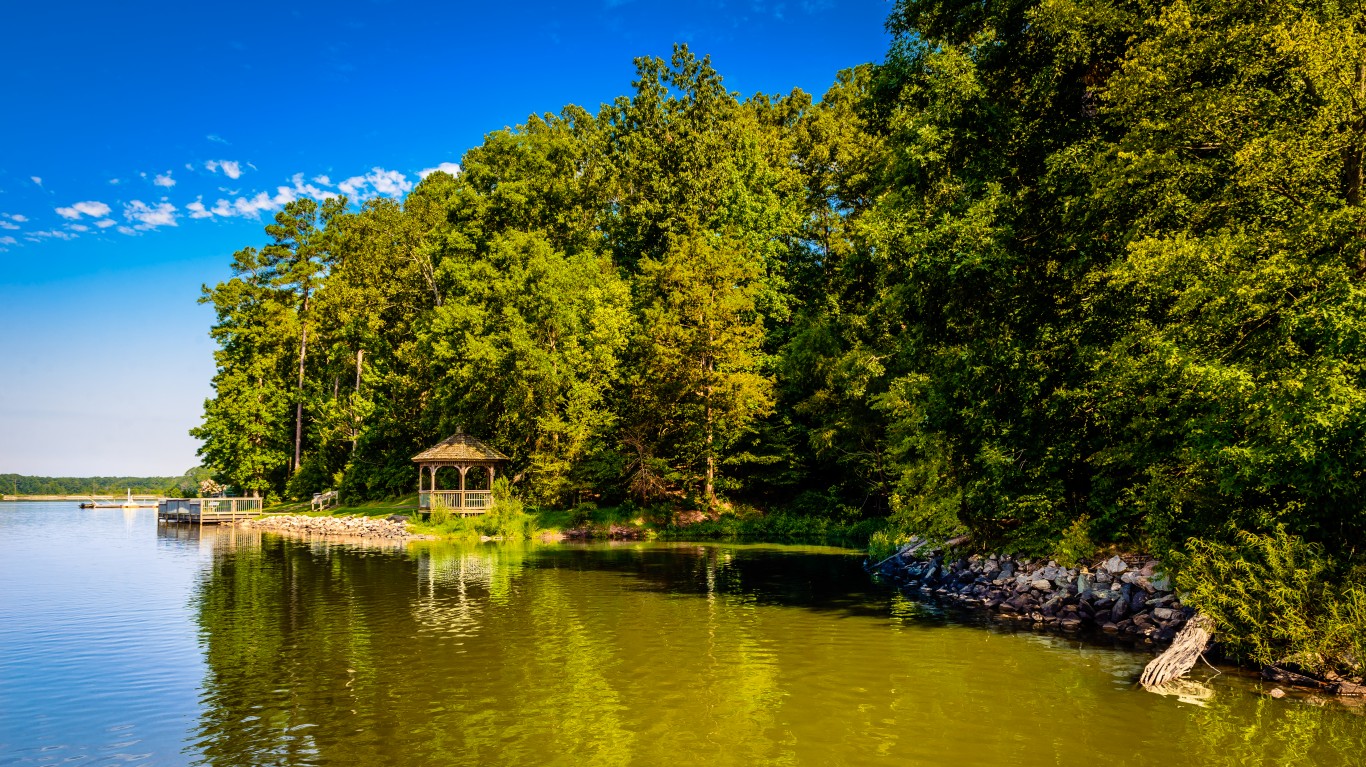
33. Morrisville, North Carolina
> Population: 22,600
> 5 yr. population change: +30.5%
> Median home value: $291,400
> Median household income: $92,769
Morrisville is situated in the middle of North Carolina’s “Research Triangle.” The cities of Raleigh, Durham, and Chapel Hill are each home to a major scientific research university — North Carolina State University, Duke University, and the University of North Carolina – Chapel Hill, respectively — and several major research-intensive industries have developed in the area.
Morrisville offers close access to each of the three universities, as well as the companies that are located nearby. Morrisville is one of the fastest-growing communities in the entire country. In the past five years, its population grew more than 30%, from just over 13,000 to 22,600.

34. Mandan, North Dakota
> Population: 20,613
> 5 yr. population change: +14.2%
> Median home value: $175,400
> Median household income: $60,034
Residents of Mandan, North Dakota benefit from a low cost of living — 13% lower than average nationwide — a five-year average unemployment rate of 2.0%, and a violent crime rate that is less than half the national rate. Mandan residents also have access to jobs, entertainment, and cultural attractions in Bismarck, the state capital located on the opposite side the Missouri River.
Recently, business leaders, elected officials, and ordinary citizens established a committee to form a comprehensive plan to improve Mandan over the coming decade. The committee’s accomplishments include broadened business support and incentives, the creation of annual festivals and events, public education improvements, and increased communication regarding local elections.
[in-text-ad-2]

35. New Albany, Ohio
> Population: 9,384
> 5 yr. population change: +25.3%
> Median home value: $492,400
> Median household income: $191,375
New Albany, Ohio, is one of the most affluent cities in the country. The median household income of $191,375 is one of the five highest of U.S. cities. Wealthier areas tend to have a number of livability advantages over low-income cities, including lower crime rates. There were just 36.9 violent crimes reported per 100,000 residents in New Albany, less than a tenth of the nationwide crime rate. New Albany also has many amenities for residents, including over 600 acres of parks and sports fields.
There are a number of factors that can draw people to certain towns, including jobs, schools, and amenities. New Albany excels in many of these aspects, and its population growth rate reflects that. The town’s population grew by more than 25% over the past five years, compared to the national growth rate of just 3.9%.
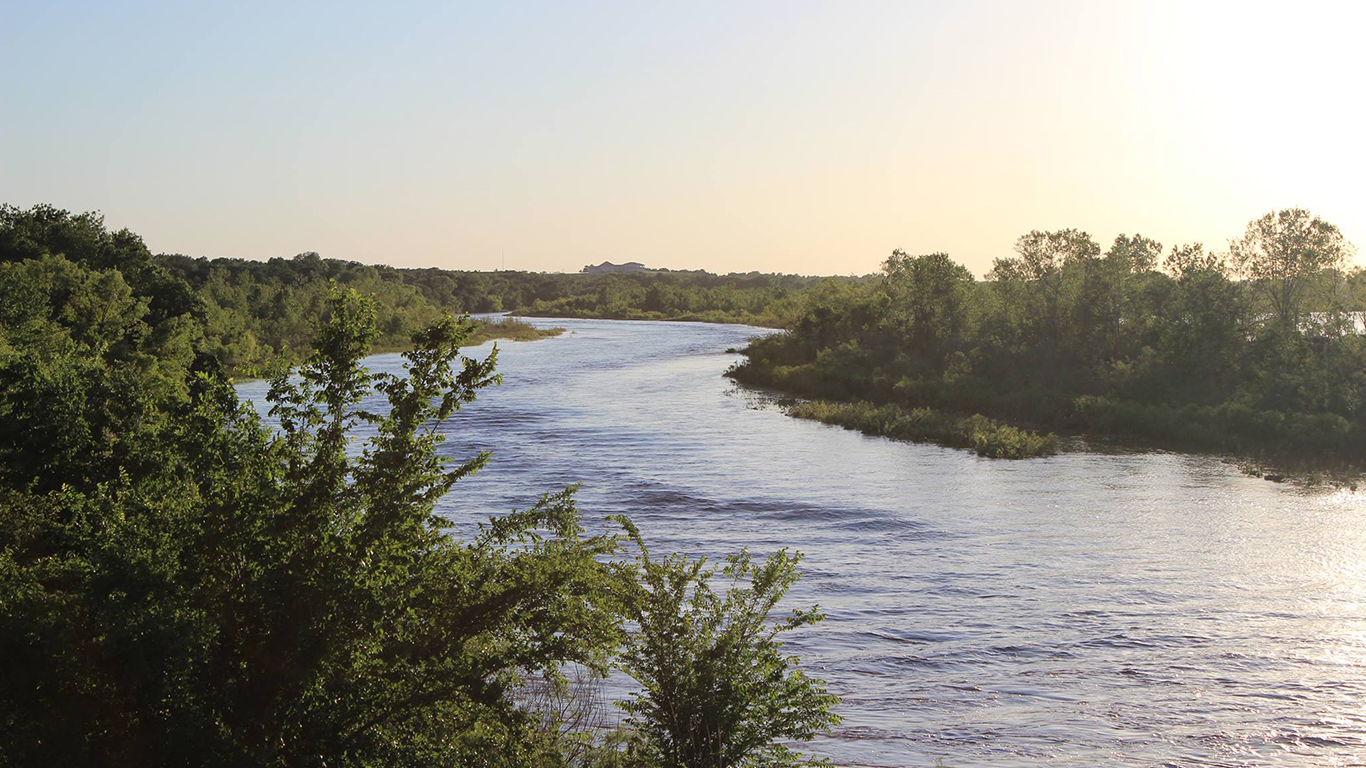
36. Newcastle, Oklahoma
> Population: 9,030
> 5 yr. population change: +21.0%
> Median home value: $180,300
> Median household income: $78,144
Newcastle is a small city of less than 10,000 just outside Oklahoma City. One of the fastest growing cities in the state, Newcastle’s population spiked by 21% in the last five years. As in other cities on this list, Newcastle residents are actively engaged in bettering their community. The city’s resident-driven Bridge to 2020 initiative launched in 2007 to develop a long-term strategic plan for the community. In addition to nearby amenities in Oklahoma City, Newcastle boasts seven golf courses, six movie theatres, access to four hospitals, and two shopping malls.
A relatively affluent city, Newcastle’s median income of $78,144 is about $30,000 higher than it is statewide and goods and services are about 17% less expensive than they are nationwide.
[in-text-ad]

37. Sherwood, Oregon
> Population: 18,965
> 5 yr. population change: +7.5%
> Median home value: $313,000
> Median household income: $86,111
Sherwood is a small city about 15 miles southwest of Portland. In addition to amenities, attractions, and employment opportunities in the nearby city, Sherwood itself boasts over a dozen parks and a community recreation center and pool.
Quality of life in Sherwood is also bolstered by a low violent crime rate and relative financial stability. There were just 82 violent crimes for every 100,000 residents in Sherwood in 2017, less than a quarter the national violent crime rate. Additionally, Sherwood’s 4.7% poverty rate is less than a third of both the state and national poverty rates of 15.7% and 15.1%, respectively.
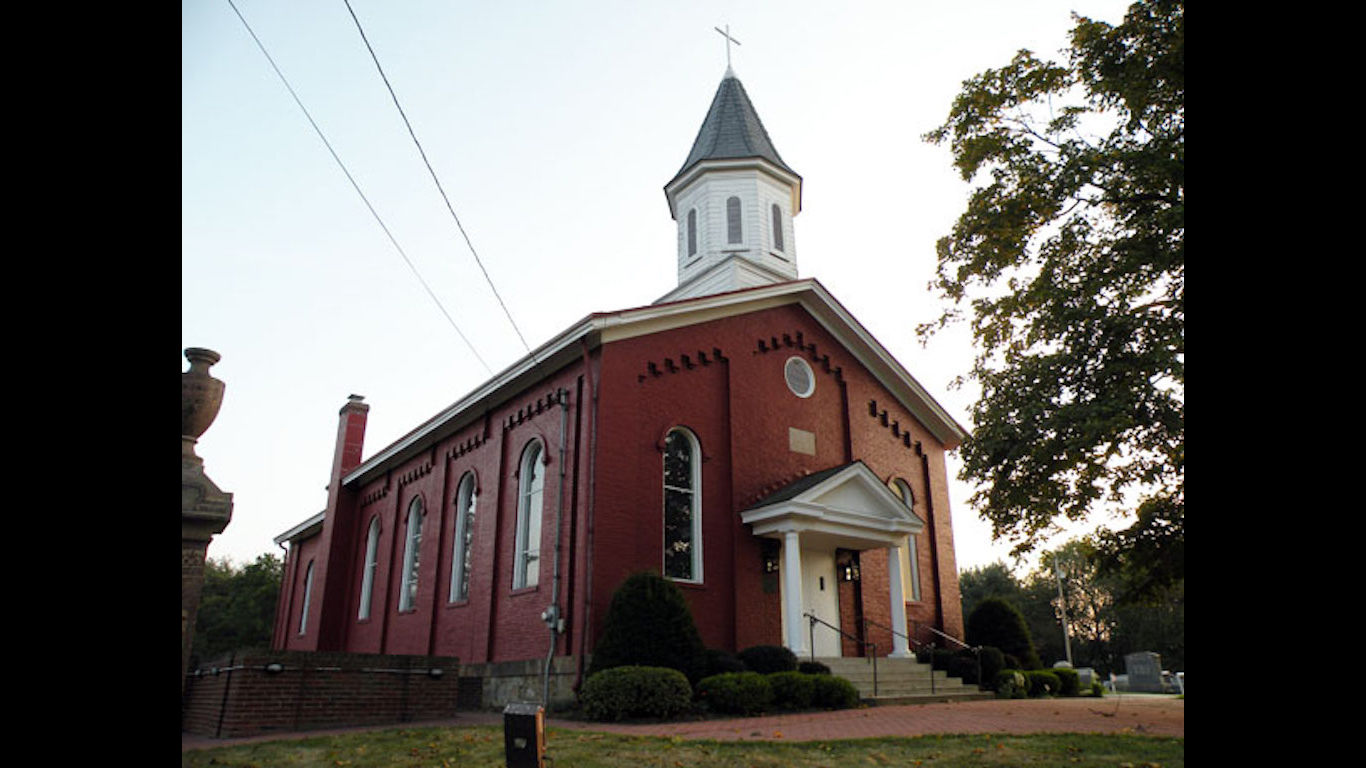
38. Franklin Park, Pennsylvania
> Population: 14,228
> 5 yr. population change: +7.9%
> Median home value: $312,200
> Median household income: $121,661
Franklin Park, Pennsylvania, is a borough just outside of Pittsburgh. The area has a relatively high share of residents with high educational attainment. A whopping 70% of adults hold at least a bachelor’s degree, one of the higher college attainment rates among U.S. cities. Those with college degrees are more qualified for specialized jobs that tend to have higher salaries. In Franklin Park, the median household income of $121,661 a year is one of the highest in the country.
Like many affluent, well-educated areas, Franklin Park is relatively safe. The violent crime rate of 14 incidents per 100,000 people is one of the lowest in the country. Nationwide, there were 383 violent crimes for every 100,000 people in 2017.
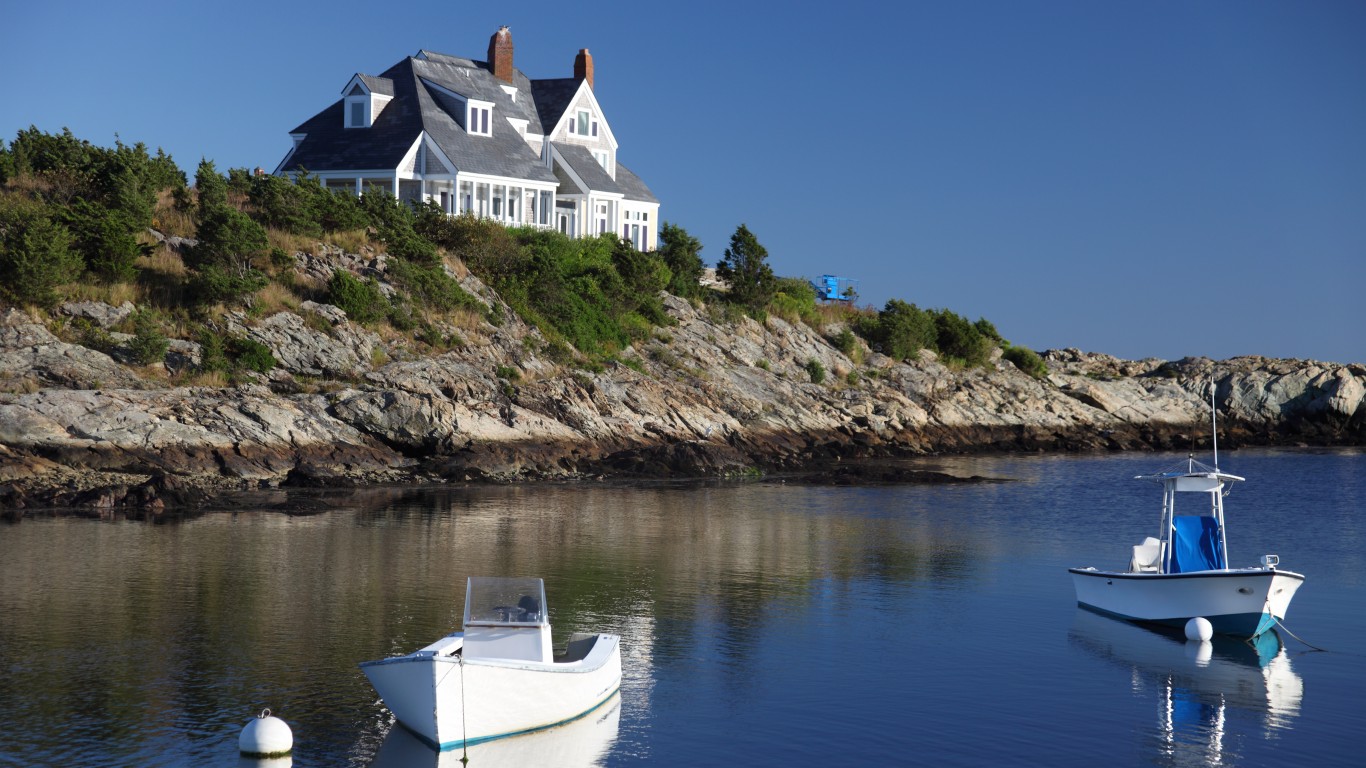
39. Newport, Rhode Island
> Population: 24,570
> 5 yr. population change: -0.1%
> Median home value: $382,200
> Median household income: $59,794
Newport, Rhode Island is by far the best educated city in the state. More than half — 50.9% — of adult residents completed at least their bachelor’s degree. No other major Rhode Island community exceeded the state’s college graduation rate of 32.5%. This high educational attainment qualifies many of the city’s residents for highly skilled jobs and likely helps drive down the unemployment rate. Newport’s unemployment rate is just 3.8%, the lowest of anywhere in the country.
Though Newport’s median household income is close to that of Rhode Island as a whole, homes in the area tend to be much more valuable than those in the rest of the state. Newport’s median home value is $382,200, well above Rhode Island’s $238,200 median home value.
[in-text-ad-2]
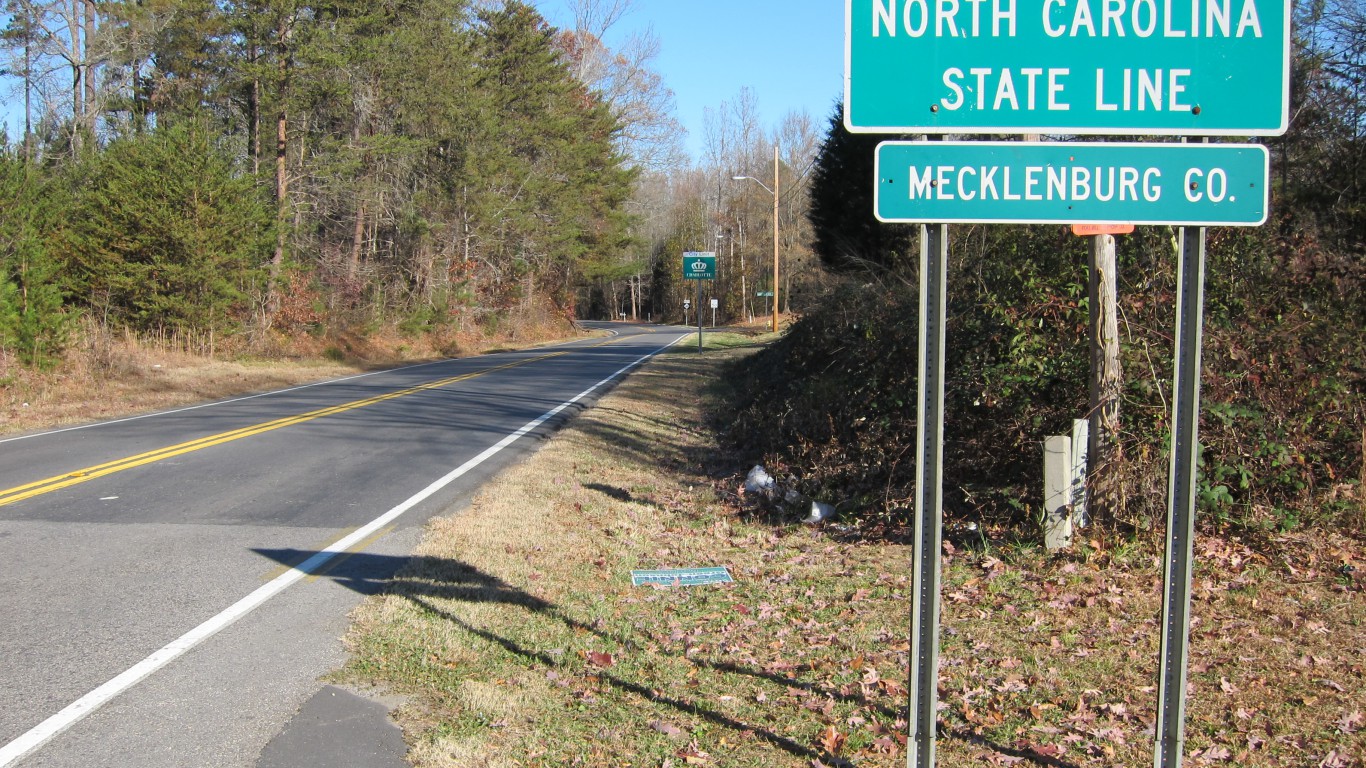
40. Tega Cay, South Carolina
> Population: 9,026
> 5 yr. population change: +23.3%
> Median home value: $301,200
> Median household income: $120,346
Tega Cay ranks as one of the best cities to live in part because of its relatively high income and the many associated benefits that come with affluence. The city’s median household income of over $120,000 is more than double the U.S. median. In a city with a high percentage of affluent households, there are also very few residents struggling with serious financial hardship. Just 0.9% of residents live in poverty.
Tega Cay lies near the border of the Carolinas and Lake Wiley. The water access gives residents a chance to swim, boat, and fish. As a tourist destination, the city has a high number of bars and restaurants per resident. Tega Cay is growing quickly. It was home to fewer than 5,000 people in 2009. As of 2016, more than 9,000 people lived there.

41. Pierre, South Dakota
> Population: 13,959
> 5 yr. population change: +2.2%
> Median home value: $164,900
> Median household income: $54,868
Most American homeowners spend more than $12,000 per year on housing. In Pierre, South Dakota, most spend less than $8,500 annually. Overall, the cost of living is lower in Pierre, as goods and services are 15% less expensive than they are on average nationwide.
Pierre, South Dakota’s capital, is home to many outdoor amenities largely thanks to its proximity to the Missouri River. Nearby Farm Island and LaFramboise Island offer residents the opportunity to take part in outdoor activities like swimming and hiking.
[in-text-ad]

42. Atoka, Tennessee
> Population: 8,917
> 5 yr. population change: +11.9%
> Median home value: $172,400
> Median household income: $87,047
Many cities and towns on this list are in close proximity to a major metropolitan area. About 25 miles northeast of Memphis, Atoka is one of them. In addition to attractions and amenities in Memphis, Atoka itself has several parks featuring playgrounds, sports fields, picnic areas, and a fishing pond.
A safe community, Atoka’s violent crime rate of 152 incidents per 100,000 people is less than half the national violent crime rate. Safe streets and proximity to a major city make Atoka an attractive place for new residents and families, and in the last five years, the city’s population expanded by 11.9%, triple the comparable 3.9% national growth rate.
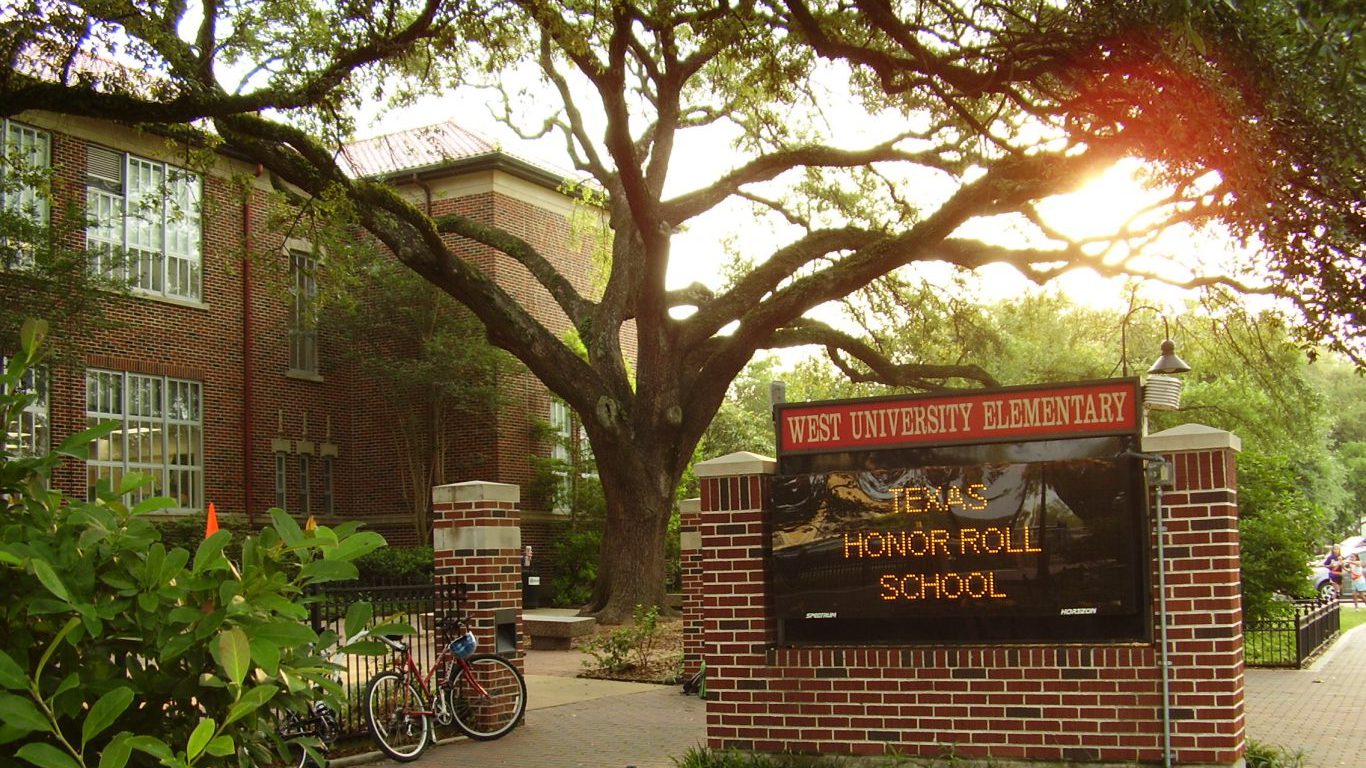
43. West University Place, Texas
> Population: 15,318
> 5 yr. population change: +4.0%
> Median home value: $917,800
> Median household income: $220,868
A wealthy suburb of Houston, West University Place ranks as the best city to live in Texas. A wealthy city, the median household income of nearly $221,000 a year is nearly four times the income the typical American household earns. A dollar also goes far in the city as goods and services are about 5% less expensive than they are nationwide on average. In addition to entertainment and culture in nearby Houston, West University has a far greater concentration of restaurants, bars, fitness centers, museums and theatre companies than is typical nationwide.
West University is also a safe city with a strong job market. The city’s violent crime rate of 64 incidents for every 100,000 people is among the lowest in the nation, as is the five-year average unemployment rate of 2.7%.
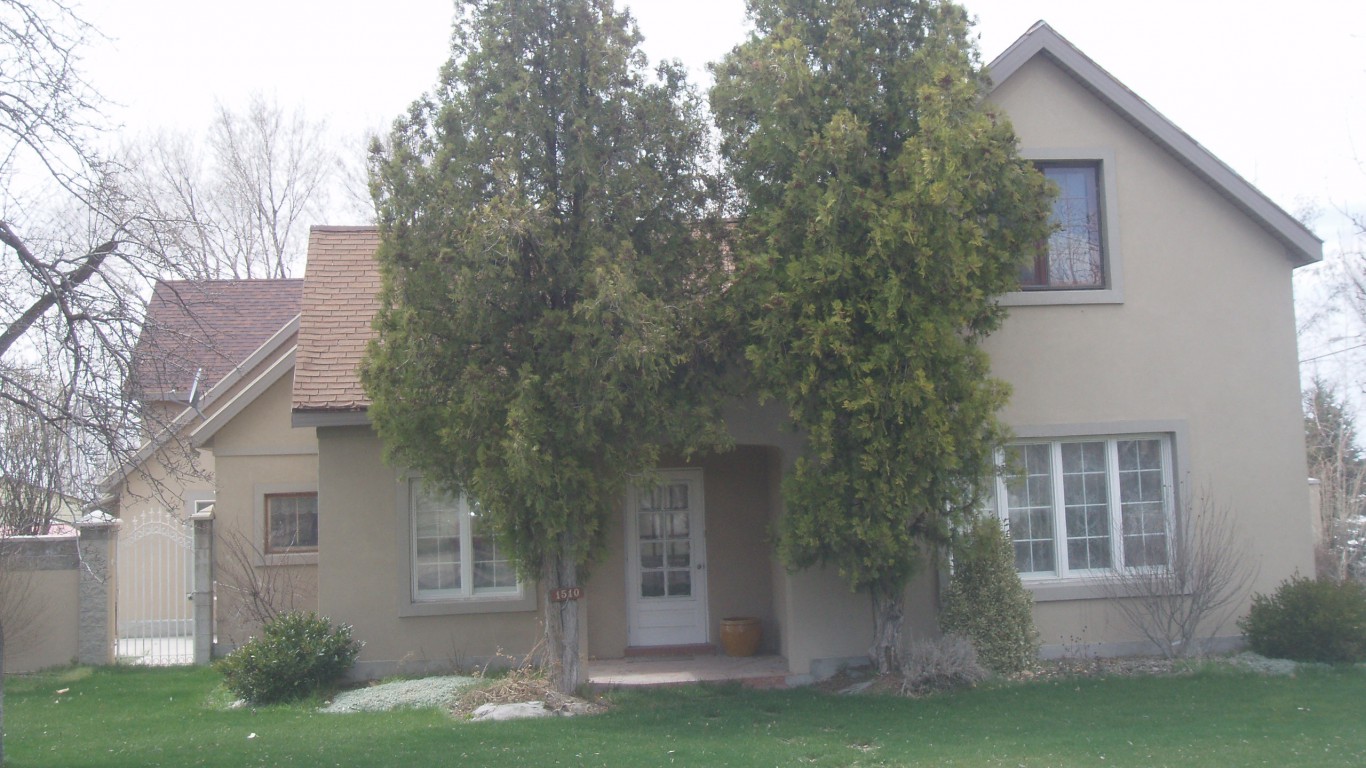
44. Woods Cross, Utah
> Population: 10,930
> 5 yr. population change: +15.5%
> Median home value: $226,200
> Median household income: $78,750
Just north of Salt Lake City, Woods Cross provides easy access to Utah’s largest city, as well as the Great Salt Lake to the west and Grandview Peak to the east. The proximity to Salt Lake City affords Woods Cross residents a short commute to the city, which may help bolster the city’s labor force participation rate. More than three quarters of Woods Cross adults, 77.4%, participate in the labor force, the most of any Utah community.
This high labor force participation likely helps drive up the median household income. The typical Woods Cross household earns $78,750 each year, well ahead of Utah’s $62,518 median household income.
[in-text-ad-2]
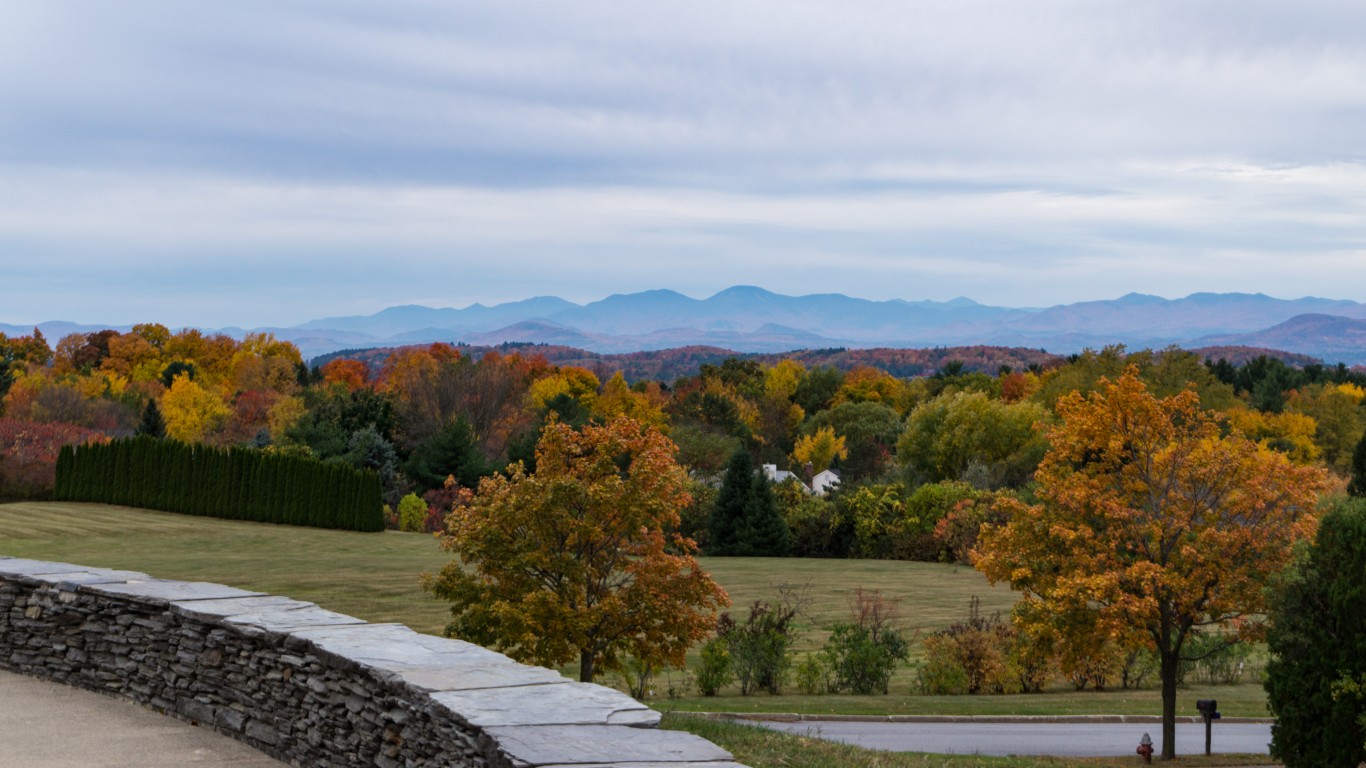
45. South Burlington, Vermont
> Population: 18,704
> 5 yr. population change: +6.2%
> Median home value: $271,900
> Median household income: $66,728
Sitting along Lake Champlain, South Burlington is adjacent to Burlington, the largest city in Vermont. With access to a number of nearby colleges, including Champlain College and the University of Vermont, South Burlington’s population is well educated. Over half of all the city’s adult residents have a bachelor’s degree or higher, well above the 30.3% national bachelor’s degree attainment rate. There are a range of employment opportunities in the area, including the University of Vermont Medical Center. Just 2.0% of workers in South Burlington were unemployed in 2017, below both the 3.0% state and 4.4% national unemployment rates.
A strong job market bolsters the financial security of area residents. Just 6.2% of South Burlington’s population live in poverty, less than half the 15.1% national poverty rate.

46. Waynesboro, Virginia
> Population: 21,366
> 5 yr. population change: +1.7%
> Median home value: $158,800
> Median household income: $45,097
Waynesboro, an independent city in northern Virginia, is notable for its affordability, safety, and scenic beauty. Goods and services in the city are about 7% less expensive than they are nationwide on average. Additionally, the violent crime rate of 182 incidents per 100,000 people is less than half the U.S. violent crime rate of 383 per 100,000.
Located in the Shenandoah Valley, Waynesboro offers easy access to the scenic Blue Ridge Parkway and the Appalachian Trail. The South River cuts through the city, providing a water trail for residents to fish and enjoy by boat. Waynesboro also has a higher than typical concentration of restaurants, movie theatres, and museums.
[in-text-ad]

47. Snoqualmie, Washington
> Population: 12,510
> 5 yr. population change: +28.3%
> Median home value: $471,800
> Median household income: $131,453
Snoqualmie, Washington, is one of the safest places in the country, with just 15 violent crimes for every 100,000 city residents in 2017. The town’s property crime rate of 1,077 incidents per 100,000 residents is also less than half the national rate.
Areas with higher median household incomes tend to have less crime than lower income areas. The median annual household income in Snoqualmie, which is within commuting distance of Seattle, is $131,453 a year, one of the higher incomes among American cities. In addition to the culture and entertainment Seattle has to offer, Snoqualmie has a higher than typical concentration of restaurants, bars, museums, and movie theatres.

48. Bridgeport, West Virginia
> Population: 8,364
> 5 yr. population change: +3.9%
> Median home value: $199,000
> Median household income: $80,462
In Bridgeport, 45.3% of adults have graduated from college, nearly the highest share of cities in the state. The high college attainment rate has likely contributed to the town’s relatively high median household income of $80,462 a year. Not only is Bridgeport wealthy, but it is also inexpensive. Goods and services are 15% less expensive than average in the city.
When it comes to culture and entertainment, Bridgeport residents have options. The city is home to a far higher concentration of restaurants, bars, recreation centers, golf courses, and movie theatres than is typical nationwide.
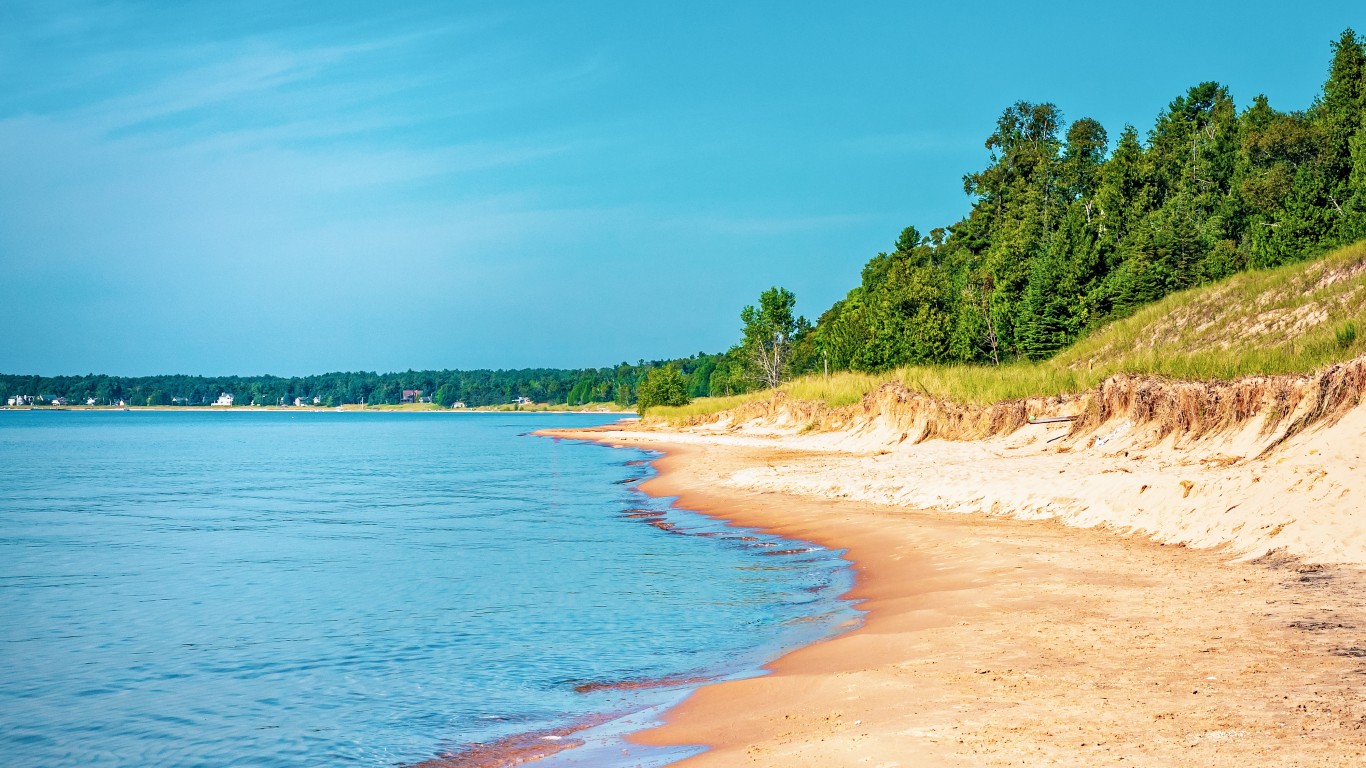
49. Whitefish Bay, Wisconsin
> Population: 14,088
> 5 yr. population change: +0.4%
> Median home value: $350,700
> Median household income: $105,156
Whitefish Bay, a Milwaukee suburb along the shore of Lake Michigan, ranks as the best place to live in Wisconsin. The high quality of life in Whitefish Bay is partially the result of a strong job market. The area’s average unemployment rate over the last five years stands at just 3.2% — less than half the comparable nationwide rate of of 7.4%.
Whitefish Bay is also one of the safest communities in the country, with a violent crime rate of just 36 incidents per 100,000 people. For reference, there were 383 violent crimes per 100,000 people nationwide in 2017.
[in-text-ad-2]

50. Jackson, Wyoming
> Population: 10,279
> 5 yr. population change: +7.6%
> Median home value: $573,400
> Median household income: $70,517
The resort town of Jackson ranks as the best place to live in Wyoming. Jackson boasts a high concentration of restaurants, bars, museums, and movie theatres, as well as access to Jackson Hole, one of the most famous ski resorts in the United States.
Incomes are relatively high in Jackson. The typical area household earns $70,517 a year, about $11,000 more than the typical Wyoming household. Higher incomes are not enough to offset the area’s high cost of living, however, as goods and services are about 35% more expensive in Jackson than they are on average nationwide. Housing is particularly expensive as most area homes are worth over half a million dollars.
Methodology
To identify the best cities to live in every state, 24/7 Wall St. created a weighted index of 26 measures that fall into one of four categories: affordability, economy, quality of life, and community.
In the affordability category, the ratio of the median home value to the median income was given full weight. Cities where the median home value is closer to the median household income were rewarded. Cost of living, as determined by the average cost of goods and services in an area relative to the nation as a whole, was given a full weight. Property taxes are largely levied at the local level, and cities where residents pay more property taxes as a percentage of their home value were penalized. Property taxes were given a one-quarter weighting.
In the economy category, we gave median household income full weighting. The unemployment rate was also given a full weight. We used five-year average unemployment due to lack of comparable annual data at local levels. Two-year employment growth and share of the total working age population with a job were each given a half weight, favoring areas with more and growing jobs opportunities.
In the quality of life category, the poverty rate was given a full weight, penalizing cities where serious financial hardship is more common. The share of the population that struggles to put food on the table either due to low income or distance from a grocery store, known as the food insecurity rate, was given full weight. A city’s mortality rate, calculated as the number of people who died while in hospital care per hospital by city, was also given full weight. In cases where city-level data was not available, mortality rates were imputed from county-level data.
The drug overdose mortality rate was given a one-quarter weighting, as was the hospital readmission rate, or the share of those released from the hospital who were readmitted within 30 days. Distance from the center of the city to the nearest hospital was given full weight.
Measures used in the community category include the average travel time to work, which was given full weight. The violent crime rate — the total number of rapes, robberies, murders, and aggravated assaults per 100,000 people — was given full weight. So too was the property crime rate, which is the total number of burglaries, larcenies, motor vehicle thefts, and incidents of arson per 100,000 people.
The share of commuters either walking, cycling, or taking public transit to work was given half weight. The total number of colleges in the area and the number of restaurants, bars, museums, theatre companies, movie theatres, libraries, and parks per capita were each given a one-quarter weighting.
The number of hospitalizations that would have been prevented by regularly scheduled doctor visits for every 1,000 Medicare enrollees — known as the preventable hospitalization rate — was given half weighting.
Median household income, median home value, average travel time to work, poverty rate, population, employment-to-population ratio, median property taxes paid, and average unemployment rate are all five-year estimates from the U.S. Census Bureau’s American Community Survey and are for 2016. Overall cost of living is for 2014 and comes from data analysis and aggregation company ATTOM Data Solutions.
The population-adjusted number of entertainment and cultural venues like restaurants and museums comes from the Census Bureau’s County Business Patterns data set, and is for 2016. The number of colleges comes from the Department of Education College Navigator and is as of the 2017-2018 school year.
Violent and property crime rates are from the FBI’s 2017 Uniform Crime Report. Drug overdose mortality rates are from the Centers for Disease Control and Prevention and are for the years 2014-2016. Mortality rates and hospital readmission rates are from the Centers for Medicare and Medicaid Services and are as of June 2015. Preventable hospitalizations are from the latest release from County Health Rankings & Roadmaps, a Robert Wood Johnson Foundation and University of Wisconsin Population Health Institute joint program.
The thought of burdening your family with a financial disaster is most Americans’ nightmare. However, recent studies show that over 100 million Americans still don’t have proper life insurance in the event they pass away.
Life insurance can bring peace of mind – ensuring your loved ones are safeguarded against unforeseen expenses and debts. With premiums often lower than expected and a variety of plans tailored to different life stages and health conditions, securing a policy is more accessible than ever.
A quick, no-obligation quote can provide valuable insight into what’s available and what might best suit your family’s needs. Life insurance is a simple step you can take today to help secure peace of mind for your loved ones tomorrow.
Click here to learn how to get a quote in just a few minutes.
Thank you for reading! Have some feedback for us?
Contact the 24/7 Wall St. editorial team.